Abstract
Seven new species of the genus Cherax from the western region of Western New Guinea, Indonesia, are described and illustrated. All new species—Cherax veritas n. sp. from the southeastern part of Misool Island of Raja Ampat Regency, Southwest Papua; Cherax arguni n. sp. and Cherax kaimana n. sp. from the northern part of Kaimana Regency, West Papua; Cherax nigli n. sp. from the southeastern part of Kaimana Regency, West Papua; Cherax bomberai n. sp. from the northeastern part of the Fakfak Regency, West Papua; Cherax farhadii n. sp. and Cherax doberai n. sp. from the Teluk Bintuni Regency, West Papua—belong to the northern group of Cherax. The new species are compared with their closest relatives, from which they can all be easily distinguished by morphological characters, such as the shape of the chelae, rostrum, body, and by their coloration. A molecular phylogeny based on a mitochondrial gene fragment, 16S, supports the morphology-based description of the seven new species, which can also be clearly distinguished by sequence differences.
1. Introduction
The crayfishes of the island of New Guinea of the genus Cherax, which is a species-rich taxon occurring in Indonesia (Western New Guinea), Papua New Guinea, and Australia, were extensively studied by Holthuis [1,2,3,4,5,6], with additions by Lukhaup and Pekny [7,8], Lukhaup and Herbert [9], Lukhaup [10], Lukhaup et al. [11,12,13,14], Patoka et al. [15,16,17,18], and Lukhaup and Eprilurahman [19].
Over the last two decades, an increasing number of colorful crayfish species from Western New Guinea, Indonesia, have been sold in the ornamental aquarium trade in Europe and Asia, leading to the description of 13 new species [7,8,10,11,12,13,14,15,16,17,18,19]. Here, we report on seven more new species that have been provided through the pet trade between 2019 and 2025 (Export No. IDREX9120304170195). In May 2019, the first author received two species that were collected by a crayfish enthusiast in Papua and sent to us by Maju Aquarium in Jakarta. According to the collector, they were both from the same unnamed creek in the Teluk Bintuni Regency, West Papua. They were imported as Cherax sp. “Red cheek” and Cherax sp. “Blue”. In June 2022, Liauw Pauw Phing, a well-known crayfish enthusiast, and his team were able to find a crayfish in an unnamed creek on Misool Island close to the village Tomolol in the southeastern part of Misool Island of Raja Ampat Regency, Southwest Papua, which was shipped to Aquarium Dietzenbach and provided to the first author as Cherax sp. “Amethyst”. In January 2024, the first author received some photos of four more undescribed crayfish species from Mr. Phing. In December 2024, three of these species from the northeastern and southeastern parts of the Bomberai Peninsula, West Papua, were introduced to the pet trade under the name Cherax sp. “Devil”, Cherax sp. “Creamy Blue”, and Cherax sp. “Orange Line”. In January 2025, we received the fourth species from the southwestern part of the Kaimana Regency, which is now traded under the name Cherax sp. “Peacock”. All four species were shipped exclusively to Mr. Nigl from Aquarium Dietzenbach in Germany by Mr. Phing and his team. In the present contribution, all seven above-mentioned species are described as new to science and compared to their congeners. To protect the species, we have chosen not to disclose the exact locations in some cases.
2. Materials and Methods
All new species were collected by local collectors from the villages close to the sampling sites. The crayfish were normally kept for several days in cages in the river before they were picked up for transport to Jakarta and then to Germany. Upon arrival in Germany, the individuals of all new species were photographed and kept alive in aquariums until samples were obtained for DNA analysis. Subsequently, the animals were preserved in 70% ethanol. Morphometric parameters of all specimens were taken using an electronic digital caliper with an accuracy of 0.1 mm. The localities of all examined specimens are provided in Table 1.
For the molecular analyses, sequences from an additional 20 species of Cherax and two other Parastacid genera used as outgroups were downloaded from GenBank (see Table 1).
All studied material has been deposited at the Museum Zoologicum Bogoriense (=Bidang Zoologi), Research Centre for Biosystematics and Evolution (=Pusat Riset Biosistematika dan Evolusi), National Research and Innovation Agency (=BRIN), Jalan Raya Jakarta-Bogor Km 46 Cibinong 16911, Indonesia (MZB), and the Museum für Naturkunde, Leibniz Institute for Evolution and Biodiversity Science, Berlin (ZMB).
DNA was purified from about 2 mm3 of muscle tissue with a Qiagen QiaCube using the manufacturers’ protocol. The polymerase chain reaction (PCR) was used to amplify two mitochondrial gene fragments, a ~535 bp region of the 16S ribosomal RNA gene (16S) using primers 1471 and 1472 [20] and a 658 bp fragment of the cytochrome oxidase subunit 1 gene (COI) using primers LCO1490 and HCO2198 [21]. The PCR was performed in 25 μL volumes containing 1x Taq buffer, 1.5 mM MgCl2, 200 μM each dNTP, 1 U Taq polymerase, ca. 50–100 ng DNA, and ddH2O. After an initial denaturation step of 3 min at 94 °C, the cycling conditions were 35 cycles at 94 °C for 35 s, 50 °C (16S) or 45 °C (COI) for 60 s, and 72 °C for 90 s, with a final elongation step of 5 min at 72 °C. The same primers were used in PCR and sequencing. The PCR products were sent to Macrogen Europe for the purification and cycle sequencing of both strands of each gene. The 16S sequences were aligned with MAFFT [22] using the G-INS-i strategy suitable for thorough alignments of sequences with global homology. The resulting alignment had a length of 543 bp. To determine the best substitution model for Bayesian information analyses (see below), hierarchical likelihood ratio tests were carried out with jModelTest [23] (24 models tested) for each gene separately. Based on the Akaike information criterion, the GTR + G and GTR + I + G models were chosen for 16S and COI, respectively. Phylogenetic trees were reconstructed by maximum parsimony (MP) using the heuristic search algorithm, as implemented in PAUP* [24], with gaps treated as the fifth base. Support for nodes was estimated by bootstrap analysis (1000 bootstrap replicates with 10 random addition sequence replicates each). Maximum likelihood (ML) analyses were run with IQ-TREE [25] using W-IQ-TREE [26], and branch support was obtained through the implemented ultrafast bootstrap (10,000 replicates [27]). In addition, Bayesian inference was employed to infer phylogeny by using MrBayes 3.2.7 [28]. The MCMCMC algorithm was run with 4 independent chains for 20,000,000 generations, samplefreq = 500, and burnin = 25%, using the models specified above. All analyses (MP, ML, and BI) were conducted both on the 16S dataset and a concatenated 16S–COI alignment. As the COI dataset lacked representatives of three of the new species and two other species of Cherax, only the 16S tree is shown, and the combined tree is provided in the Supplementary Material. Genetic distances were calculated using MEGA 11.0.13 [29]. All new sequences have been deposited in GenBank (see Table 1).

Table 1.
Materials studied, with GenBank accession numbers. Sequences of species represented by more than one sequence are listed consecutively, as labeled in Table 1.
Table 1.
Materials studied, with GenBank accession numbers. Sequences of species represented by more than one sequence are listed consecutively, as labeled in Table 1.
| GenBank Acc. No. | ||||
|---|---|---|---|---|
| Species | Location | 16S | COI | Source |
| Cherax alyciae | Unnamed creek, Boven Digoel Regency, South Papua, Indonesia; 7 December 2016 | MH457588 MH457589 MH457590 | MH457597 MH457599 MH457598 | Lukhaup et al., 2018 [13] |
| Cherax arguni n. sp. | Unnamed tributary close to Rafa village, northern part of Kaimana Regency, West Papua, Indonesia; November 2024 | PV648009 PV648010 PV648011 | PV646611 PV646612 PV646613 | This study |
| Cherax boesemani | Ajamaru Lake, Maybrat Regency, Southwest Papua, Indonesia; 1°17′19.97″ S, 132°14′49.14″ E; 23 January 2016 | KY654089 KY654090 | KY654084 KY654085 | Lukhaup et al., 2017 [12] |
| Cherax bomberai n. sp. | Unnamed tributary of Otauar River drainage in the NE part of Fakfak Regency, West Papua, Indonesia; November 2024 | PV648007 PV648008 | PV646609 PV646610 | This study |
| Cherax communis | Paniai Lake, Paniai Regency, Central Papua, Indonesia | MH457602 | Lukhaup et al., 2018 [13] | |
| Cherax doberai n. sp. | Nameless creek in Teluk Bintuni Regency, West Papua, Indonesia; May 2019 | PV648012 | This study | |
| Cherax farhadii n. sp. | Nameless creek in Teluk Bintuni Regency, West Papua, Indonesia; May 2019 | PQ777191 PQ777192 | Lukhaup et al., 2024 [14] (as C. sp. A, Figure 6 in [14]) | |
| Cherax gherardii | Pet trade | KU821432 | KU821417 | Blaha et al., 2016 [30] |
| Cherax holthuisi | Uter-Aitinjo Lake, Maybrat Regency, Southwest Papua, Indonesia | KU821433 | KU821419 | Blaha et al., 2016 [30] |
| Cherax kaimana n. sp. | Unnamed tributary close to Rafa village, northern part of Kaimana Regency, West Papua, Indonesia; November 2024 | PV648006 | PV646608 | This study |
| Cherax misolicus | Misool Island, Raja Ampat Regency, Southwest Papua, Indonesia (Leiden Museum) | KJ920813 | Eprilurahman et al. (unpublished) | |
| Cherax monticola | Baliem River, Wamena, Jayawijaya Regency, Highland Papua, Indonesia | KF649851 KJ920818 | KF649851 | Gan et al., 2014 [31] |
| Cherax mosessalossa | Klademak Creek, Sorong City, Southwest Papua, Indonesia; 0°52′23.59″ S, 131°16′24.40″ E; 26 January 2016 | MH457594 MH457595 | MH457602 MH457603 | Lukhaup et al., 2018 [13] |
| Cherax nigli n. sp. | Unnamed tributary of the Lengguru River in the southeast of Kaimana Regency, West Papua, Indonesia; December 2024 | PV648013 PV648014 | PV646614 PV646615 | This study |
| Cherax paniaicus | Tage Lake, Paniai Regency, Central Papua, Indonesia | KJ920830 | KJ950528 | Eprilurahman et al. (unpublished) |
| Cherax peknyi | Unnamed creek, tributary of Fly River, Papua New Guinea | MH457591 MH457592 MH457596 | MH457600 MH457601 MH457604 | Lukhaup et al., 2018 [13] |
| Cherax phing | Unnamed creek, Klasabun River drainage basin, Sorong Regency, Southwest Papua, Indonesia; 1°02′41.8″ S, 132°15′51.9″ E; January 2020 | PQ777188 PQ777189 PQ777190 | Lukhaup et al., 2024 [14] | |
| Cherax pulcher | Hoa Creek (Teminabuan District), South Sorong Regency, Southwest Papua, Indonesia; 1°28′32.73″ S, 132°3′54.94″ E; 23 January 2016 | KY654088 | KY654083 | Lukhaup et al., 2017 [12] |
| Cherax pulverulentus | Tributaries of Ayamaru Lake, Ayamaru District, Maybrat Regency, Southwest Papua, Indonesia | PP751802 PP751803 | PP751626 PP751627 | Patoka et al., 2025 [18] |
| Cherax rayko | Unnamed creek of Bian River drainage basin, Muting District, Merauke Regency, South Papua, Indonesia; January 2015 | PQ777193 PQ777194 PQ777195 | Lukhaup et al., 2024 [14] | |
| Cherax snowden | Oinsok (Ainsok River drainage basin), Southwest Papua, Indonesia; 1°11′40,07″ S, 131°50′1.14″ E; 24 January 2016 | KY654087 | KY654082 | Lukhaup et al., 2017 [12] |
| Cherax veritas n. sp. | Creek close to Tomolol village, SE Misool Island, Raja Ampat Regency, Southwest Papua, Indonesia; June 2022 | PP777185 PP777186 PP777187 | Lukhaup et al., 2024 [14] (as C. sp. B, Figure 6 in [14]) | |
| Cherax wagenknechtae | Along banks of an unnamed creek of the Klasabun River drainage basin, Sorong Regency, Southwest Papua, Indonesia; 1°15′59.91″ S, 131°18′21.29″ E; 2016 | OP737872 OP737873 | OP712702 OP712703 | Lukhaup and Eprilurahman, 2022 [19] |
| Cherax warsamsonicus | Small tributary to Warsamson River, Sorong Regency, Southwest Papua, Indonesia; 0°49′16.62″ S, 131°23′3.34″ E; 20 January 2016 | KY654091 | KY654086 | Lukhaup et al., 2017 [12] |
| Cherax woworae | Teminabuan District, South Sorong Regency, Southwest Papua, Indonesia | OQ474905 OQ474906 | OQ476074 OQ476075 | Patoka et al., 2023 [17] |
| Engaeus strictifrons | Crawford River, Victoria, Australia | AF492812 | AF493633 | Munasinghe et al., 2003 [32] |
| Euastacus bispinosus | Crawford River, Victoria, Australia | AF492813 | AF493634 | Munasinghe et al., 2003 [32] |
3. Systematics
Parastacidae Huxley, 1879
Genus Cherax Erichson, 1846
Cherax arguni n. sp.
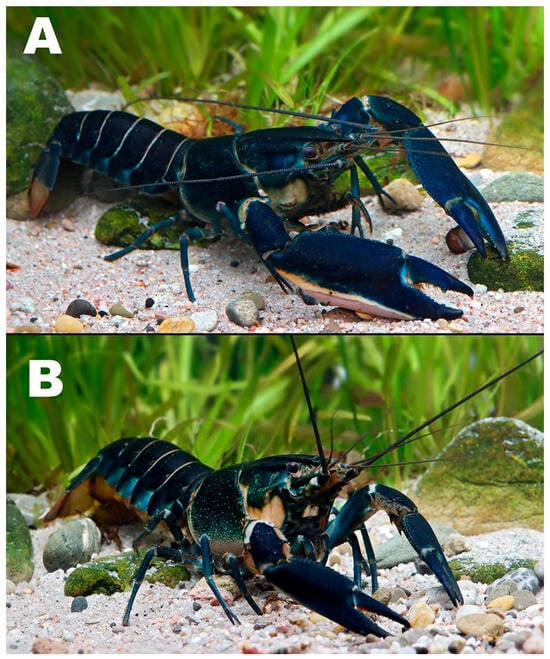
Figure 1.
Cherax arguni n. sp. (A) Holotype male (MZB Cru), unnamed creek close to Rafa, Kaimana Regency, West Papua, Indonesia. (B) Allotype (MZB Cru), same data as holotype.
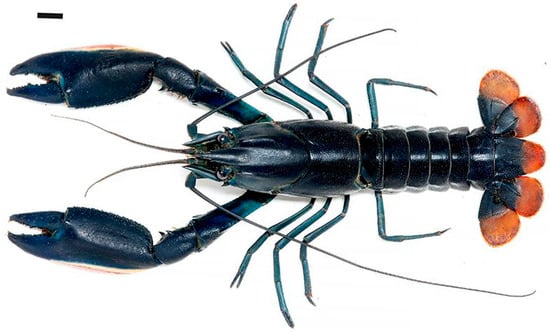
Figure 2.
Cherax arguni n. sp., holotype male (MZB Cru). Scale bar: 10 mm.
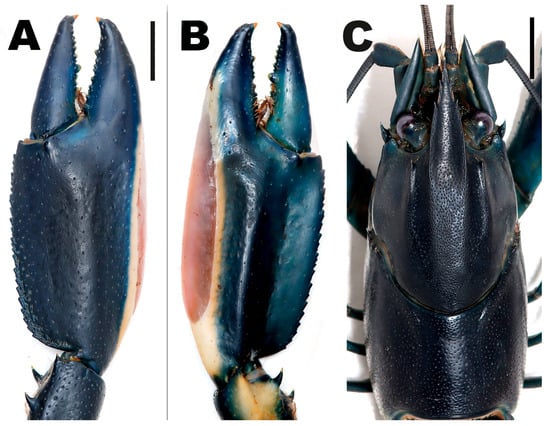
Figure 3.
Right chela and cephalothorax of Cherax arguni n. sp., holotype male (MZB Cru). (A) Right chela, dorsal view; (B) idem, ventral view; (C) cephalothorax, dorsal view. Scale bar: 10 mm.
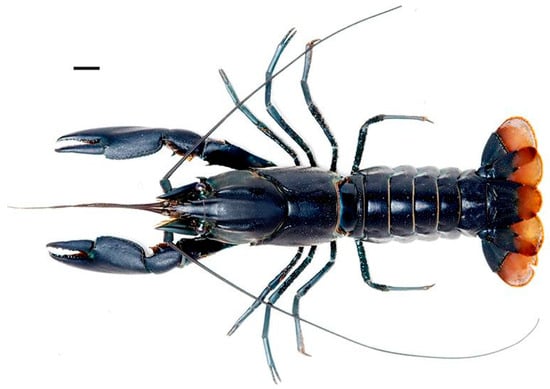
Figure 4.
Cherax arguni n. sp., allotype female (MZB Cru). Scale bar: 10 mm.
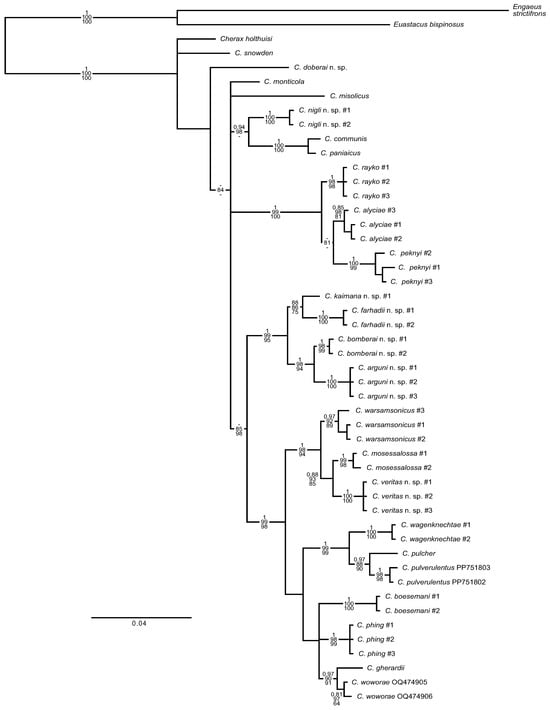
Figure 5.
Phylogenetic relationships of the seven new species of Cherax within the northern New Guinea Cherax lineage, reconstructed by BI analysis of the 16S rRNA mitochondrial gene fragment. Numbers on branches show, from the top, Bayesian posterior probabilities (>0.7) and ML/MP bootstrap values (>50). The scale bar indicates the substitution rate. See Table 1 for information on the sequenced specimens.
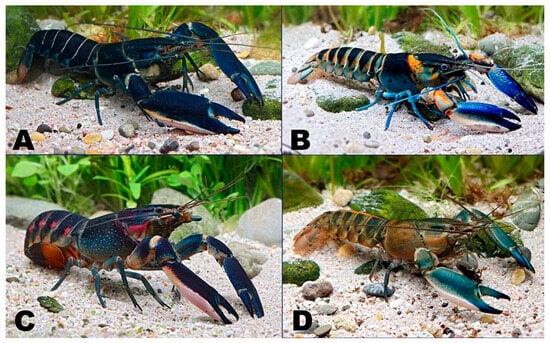
Figure 6.
Coloration comparison of Cherax arguni n. sp. (A) with C. bomberai n. sp. (B), C. farhadii n. sp. (C), and C. kaimana n. sp. (D).
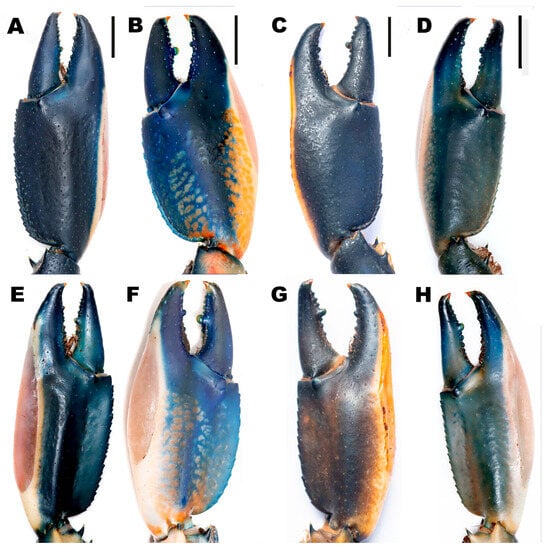
Figure 7.
Chelae comparison of Cherax arguni n. sp. (A,E) with C. bomberai n. sp. (B,F), C. farhadii n. sp. (C,G), and C. kaimana n. sp. (D,H). Top row: dorsal view; bottom row: ventral view.
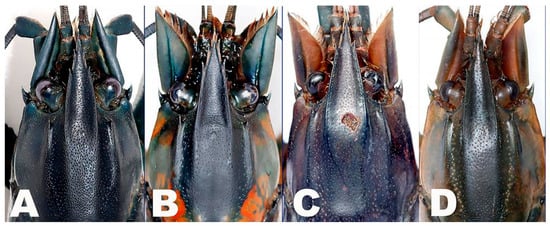
Figure 8.
Rostrum comparison of Cherax arguni n. sp. (A) with C. bomberai n. sp. (B), C. farhadii n. sp. (C), and C. kaimana n. sp. (D).
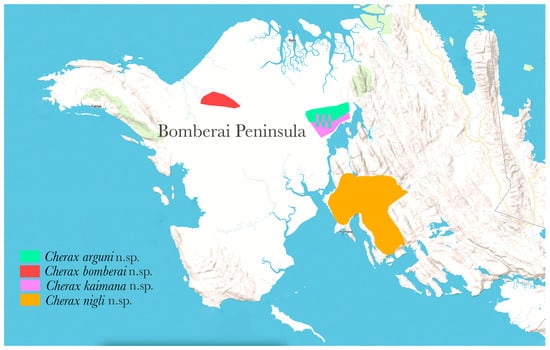
Figure 9.
The Bomberai Peninsula, West Papua, Indonesia, with the distribution of Cherax arguni n. sp., C. bomberai n. sp., C. kaimana n. sp., and C. nigli. n. sp.
Material examined. Holotype: male (MZB Cru), under rocks, wood, and among roots and in debris along banks of an unnamed tributary close to Rafa village in the northern part of the Kaimana Regency, West Papua, Indonesia. Coll. by local people, November 2024. Crayfish were sent to Aquarium Dietzenbach by KKCrayfish Farm in Jakarta. Allotype: female (MZB Cru), same data as holotype. Paratypes: one male (MZB Cru); one male and two females (ZMB 34709)—all the same data as the holotype.
Diagnosis. Carapace surface smooth with numerous tiny tubercles posterior to cervical groove on lateral carapace. Eyes large, cornea globular, darkly pigmented. Rostrum lanceolate in shape with excavated margins. Rostral margins with two prominent teeth on each side. Rostral carinae prominent. Postorbital ridges prominent with one acute tubercle at anterior terminus. Prominent uncalcified patch on outer lateral margin of chelae of adult male, white, translucent. Chelipeds dark blue and white with white joints. Fingers with hooked tips. Carapace dark blue with white translucent patch on lateral anterior part. Other walking legs dark blue. Pleon dark blue with thin, light, creamy transverse bands. Lateral pleura becoming lighter blue.
Description of male holotype (Figure 1A, Figure 2 and Figure 3A–C). Body and eyes pigmented (Figure 1A). Eyes not reduced. Cornea slightly broader than eyestalk. Body subovate, slightly compressed laterally. Pleon narrower than cephalothorax (width 23.0 mm and 27.3 mm, respectively). Rostrum (Figure 3C) broad in shape, pitted, reaching middle of the first antennular peduncle and about 2.2 times as long as wide (width 6.6 mm at base, length 14.6 mm). Margins slightly elevated continuing in rostral carinae on carapace, almost straight in basal part. Acumen with anteriorly orientated spine. Rostral margins with 2 spines on each side on anterior third of rostrum. Few scattered tiny hairs present on anterior third of rostrum. Rostral carinae extending as slight elevations posteriorly on carapace terminating at half of postorbital ridges. Postorbital ridges well developed, terminating in spiniform tubercle anteriorly, fading at half of the occipital carapace length, posteriorly. Surface between rostral carinae heavily pitted. Postorbital ridges about 1/4 of CL. Cervical and branchiocardiac grooves distinct, not setose; 4 small spines present at middle part behind cervical groove on lateral sides of carapace. Carapace (60.9 mm) surface smooth; numerous tiny granules posterior to cervical groove on lateral carapace present. Anterior margin strongly produced; rounded upper margin directed inward. Areola smooth, pitted; length 17.3 mm; narrowest width 9.7 mm. Length of areola 28.3% of total length of carapace (60.9 mm). Scaphocerite broadest at posterior third, convex in distal part becoming narrower in basal part; thickened lateral margin terminating in corneous spine, slightly overreaching ultimate segment of antennular peduncle. Left scaphocerite 16.4 mm long and 5.6 mm wide; proximal margins setose. Antennulae and antennae typical for genus. Antennae slightly longer than body. Antennal protopodite smooth, without spine, with row of hairs on inner margin; basicerite with one lateral and one ventral spine. Mouthparts typical for genus. Epistome with subcordiform cephalic lobe anteriorly bearing lanceolate cephalomedian projection constricted at base. Lateral margins of lobe thickened; each lateral margin with a group of 6–7 very small tubercles separated by smooth region. Central part smooth, not pitted, excavate. First pereopods (Figure 3A,B) equal in form, chela slightly gaping. Left cheliped 58.4 mm long, 9.7 mm high, and 21.2 mm wide. Right chelae 58.2 mm long (tip missing), 10.7 mm high, and 21.6 mm wide, strongly compressed. Fingers shorter than palm (left dactylus 21.4 mm long). Dactylus broad at base (8.2 mm), tapering slightly toward tip. Tip with sharp, corneous, hooked tooth pointing outwards at an angle of 45°. Cutting edge of dactyl with a continuous row of small granular teeth and one slightly larger granule at mid-length. Ventral and dorsal surface of movable finger smooth with scattered punctuation. Ventral posterior half of cutting edge with scattered setae reaching from base to larger granule. Fixed finger smooth, scattered punctuation, triangular, merging gradually into palm, ending in sharp, corneous, hooked tooth, parallel to x-axis of finger. Tips of fingers slightly cross when fingers clasp. Upper surface of palm practically smooth, slightly pitted, more densely pitted at margins. Fixed finger broader than dactyl at base (9.8 mm). Dense short setae present in the posterior ventral part of fixed finger, reaching from palm to about one-third of cutting edge. Cutting edge of fixed finger with row of seven rather small granular teeth and one bigger one after first third.
Outer lateral margin of chelae smooth with a white, translucent patch covering about half of lateral margin. Row of 23–24 slightly elevated mesial propodal granules at dorsolateral margin. Dorsolateral margins slightly elevated in posterior third. Scattered, short hairs present on posterior half of lateral margin. Dorsal surface of carpus (17.3 mm) smooth, with slight excavation in middle part and with two well-developed mesial carpal spines. Ventral carpal surface margins slightly elevated, setose, with fovea; inner margin with well-developed ventral carpal spine and prominent ventromesial carpal spine oriented at an angle of approximately 45°. Merus (27.8 mm) laterally depressed in basal part; surface smooth, pitted; prominent dorsal meral spine present. Inner ventrolateral margin smooth; four ventral meral spines present: one at first third, one at mid-length, other at tip of anterior part, and fourth on distal ventrolateral inner margin. Ischium (15.9 mm) smooth with three small granules at ventrolateral inner margin.
Second pereopods reaching anteriorly to approximately mid-length of scaphocerite. Propodus (14.0 mm) and dactylus (7.0 mm) slightly longer than fixed finger (5.8 mm), of same height. Few scattered, short setae present on posterior part of dactyl and fixed finger. Cutting edge of dactyl and propodus with row of dense, short setae. Carpus (11.2 mm), smooth, slightly pitted. Merus 18.4 mm. Ischium (8.7 mm) about half as long as merus.
Third pereopods overreaching second pereopods to mid-length of carpus. Fingers shorter than palm. Dactylus (6.7 mm) with corneous tip; short, scattered hairs present in posterior half. Propodus (17.0 mm) about three times as long as dactylus, somewhat flattened. Carpus (15.1 mm) more than twice as long as dactylus. Merus 21.6 mm. Fourth pereopods reaching distal margin of scaphocerite. Dactylus (5.7 mm) with corneous tip; short, scattered setae present. Propodus (13.8 mm) about 2.5 times as long as dactylus, somewhat flattened, carrying scattered stiff setae on lower margin. Carpus (9.0 mm) about twice as long as dactylus. Merus 16.3 mm. Fifth pereopods similar to fourth, shorter. Dorsal surface of pleon smooth, heavily pitted; abdominal segments (1–5) with short, creamy colored setae present on caudal margins of segment. Pleon length 69.1 mm. Telson with posterolateral spines; dense short setae present in posterior third; posterior margins setose. Uropodal protopod with two distal spines on mesial lobe. Exopod of uropod with transverse row of posteriorly directed diminutive spines ending in one more prominent spine, posteriorly directed on outer margin of mesial lobe. Terminal half of exopod with small spines and short hairs, slightly corrugated. Endopod of uropod smooth. Short, scattered hairs present on posterior third of dorsal exopod. Posterolateral spine on outer margin present. Second spine on medial dorsal surface present, directed posteriorly. Total length 130.0 mm.
Description of female allotype (Figure 4). Chela of first pereopods equal, three times as long as broad (46.3 mm and 15.1 mm, respectively). Mesial margin of palm slightly elevated, forming slender serrated ridge with row of 15–16 small granular teeth. Cutting edge of dactylus with 10–11 rather small granular teeth. Cutting edge of fixed finger with 11–12 small granules, one slightly bigger. Small scattered, short setae visible along ventral cutting edges of chelae, denser and longer in ventral posterior half. Tips of fingers slightly cross when fingers clasp, slightly gaping. No soft patch present. Pleon slightly narrower than cephalothorax (width 28.5 mm and 28.9 mm, respectively). Rostrum broad in shape, reaching middle of first antennular peduncle and about 2.4 times as long as wide (width 7.8 mm at base, length 18.8 mm). Margins slightly elevated, continuing in rostral carinae on carapace, almost straight in basal part, distal third, pointing upwards at an angle of approximately 45°. Rostral margins with three spines on each side on anterior third of rostrum. Acumen with anteriorly orientated spine. Few scattered hairs present on anterior third of rostrum. Rostral carinae extending as slight elevations posteriorly on carapace, terminating at half of postorbital ridges. Postorbital ridges well developed, terminating in spiniform tubercle anteriorly, fading at half of occipital carapace length, posteriorly. Postorbital ridges about 1/4 of CL. Cervical and branchiocardiac grooves distinct, not setose; four well-developed spines present at middle part behind cervical groove on lateral sides of one side of carapace and three on the other. Carapace surface smooth; numerous tiny granules posterior to cervical groove on lateral carapace present. Anterior margin strongly produced; rounded upper margin directed inward. Areola smooth, pitted; length, 19.5 mm; narrowest width, 11.8 mm. Length of areola 29.1% of total length of carapace (66.8 mm). Same color pattern as in males. Pleon length 76.7 mm. Total length 143.5 mm.
Size. The variation in size in the studied sample of C. arguni n. sp. is given in Table 2, which also provides comparisons with all other newly described species.

Table 2.
Morphometric measurement comparisons for the seven species described in the present study (Cherax arguni n. sp., C. bomberai n. sp., C. doberai n. sp., C. farhadii n. sp., C. kaimana n. sp., C. nigli n. sp, and C. veritas n. sp.,), showing means, standard deviation, and range. All measurements are in mm.
Color. The living animals (Figure 1A,B) are colored as follows. Individuals of Cherax arguni n. sp. usually have dark blue and white chelipeds with white joints. Carapace dark blue with a creamy patch on lateral anterior part. The other walking legs are dark blue. Pleon dark blue with thin, light, creamy transverse bands. Lateral pleura becoming lighter blue. Females: same color as males with smaller chelae. Females do not show the white translucent soft patch.
Molecular phylogenetic results. Cherax arguni n. sp. forms a highly supported, distinct clade that is the well-supported sister species to C. bomberai n. sp.; both species are, in turn, sister to a moderately supported clade comprising C. kaimana n. sp. and C. farhadii n. sp. (Figure 5). The clade comprising these four species is highly supported and very distinct; it is sister group to a clade comprising ten species, including, e.g., C. veritas n. sp. and C. pulcher, but this relationship is only partially supported. Cherax arguni n. sp. is well isolated from C. bomberai n. sp. and C. kaimana n. sp./C. farhadii n. sp., with a sequence divergence (p-distance) of 1.7–1.9% (16S)/7.8% (COI) and 3.0–3.8% (16S)/11.4% (COI; C. kaimana n. sp. only), respectively, supporting the morphology-based description of C. arguni as a new species.
Systematic position. Cherax arguni n. sp. belongs to the northern species group lineage, now consisting of 35 species (please see the respective section for C. nigli n. sp. below for details).
Systematic remarks. In comparison to all species of the northern group, the new species, Cherax arguni n. sp., is morphologically and genetically most similar to C. bomberai n. sp., to C. farhadii n. sp., and to C. kaimana n. sp. Cherax arguni n. sp. may be easily distinguished from these three species by the coloration and pattern of live individuals (Figure 6), by the shape of the chelae (Figure 7), by the shape of the rostrum (Figure 8), and by DNA barcoding (Figure 5).
Coloration comparison (Figure 6A–D). Individuals of Cherax arguni n. sp. (Figure 6A) usually have dark blue and white chelipeds with white joints. Carapace dark blue with a creamy patch on the lateral anterior part. Other walking legs dark blue. Pleon dark blue with thin, light, creamy transverse bands. Lateral pleura becoming lighter blue. C. bomberai n. sp. (Figure 6B) usually has blue and white chelipeds with white joints. Prominent uncalcified patch on lateral margin of chelae of adult male, white, translucent. Carapace dark blue with orange and greenish stains on the anterior carapace. Fingers with hooked tips. Other walking legs light blue to dark blue. Pleon dark blue with light greenish-blue and creamy transverse bands. Lateral pleura becoming lighter blue-green. C. farhadii n. sp. (Figure 6C) usually has blue chelipeds with white joints. Uncalcified patch on lateral margin of chelae, white, translucent. Fingers with hooked tips. Carapace dark blue or greenish blue, becoming lighter laterally. Numerous creamy to white small spots on lateral and dorsal carapace. Walking legs light blue to dark blue. Pleon dark blue with creamy transverse bands. Lateral pleura becoming lighter green or blue to creamy. Some animals with a pink lateral dot on five segments, others with a yellowish to greenish dot. C. kaimana n. sp. (Figure 6D) usually has blue-greenish and white chelipeds with white joints. Fingers dark blue with orange-yellowish hooked tips. Carpus same color as chela. Body is usually green on top, becoming creamy orange ventrally. Walking legs greyish-blue, sometimes greenish-blue. Pleon dark green to orange, creamy, with creamy transverse bands. Lateral pleura becoming creamy orange with some green. Bright orange lengthwise narrow band from the first segment of the pleon to the fifth segment.
Chelae comparison (Figure 7A–F). In C. arguni n. sp., the dorsolateral margins have a row of 23–24 slightly elevated mesial propodal granules at the dorsolateral margin, while 11–12 in C. bomberai n. sp., 11–12 in C. farhadii n. sp., and 19–20 in C. kaimana n. sp. In C. arguni n. sp., the chelae are 2.9 times longer than the movable finger, while in C. bomberai n. sp., the chelae are 2.7 times longer, in C. farhadii n. sp., 2.7 times longer, and in C. kaimana n. sp., they are 2.6 times longer than the movable finger. In C. arguni n. sp., the chelae are 2.6 times as long as broad, in C. bomberai n. sp. 2.3 times, in C. farhadii n. sp. 2.6 times, and in C. kaimana n. sp. 2.7 times as long as broad. In C. arguni n. sp., the claw is not gapping, with longer dense setae in the ventral third, in C. bomberai n. sp., the claw is slightly gapping, with dense short setae in the ventral third of the movable and fixed fingers, in C. farhadii n. sp. there is a moderate wide gap and scattered, short setae present in the ventral third of the movable and fixed fingers, while it is slightly gapping in C. kaimana n. sp., with scattered, short hairs present in the ventral third of the movable and fixed fingers.
Rostrum comparison (Figure 8A–C). The rostrum of Cherax arguni n. sp. is well developed and 2.4 times longer than broad, slightly bending outwards, and the rostrum of C. bomberai n. sp. is 2.3 times longer than broad, rather straight, and triangular shaped. The rostrum of C. farhadii n. sp. is 2.2 times as long as broad, while the rostrum of C. kaimana n. sp. is rather straight and triangular shaped and 2.7 times as long as broad.
Distribution (Figure 9). Cherax arguni n. sp. has so far only been found in creeks close to the village of Rafa in the northern part of Kaimana Regency, together with C. kaimana n. sp. It likely occurs at least throughout the entire catchment.
Common name. As the common name for this crayfish, we propose the Arguni Creamy Blue Crayfish.
Etymology. Arguni is an endangered indigenous language of Indonesia and is spoken on the Bomberai Peninsula, where the species is endemic. It is proposed as a noun in apposition.
Cherax bomberain. sp.
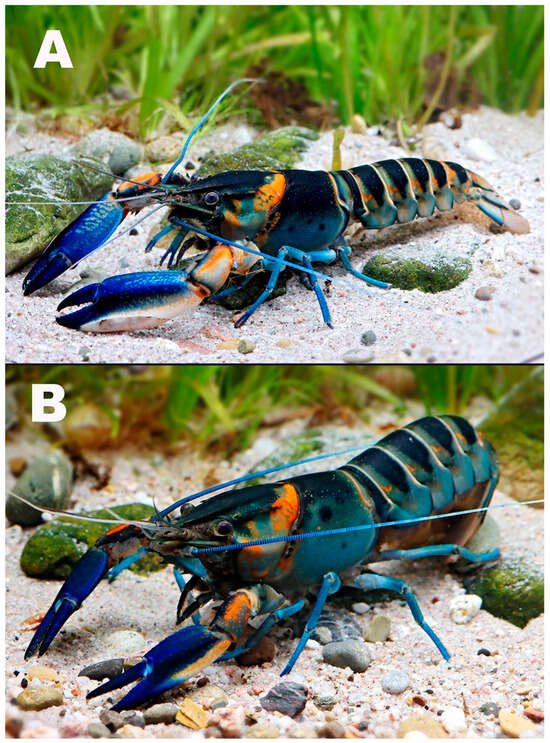
Figure 10.
Cherax bomberai n. sp. (A) Holotype male (MZB Cru). (B) Allotype (MZB Cru), same data as holotype.
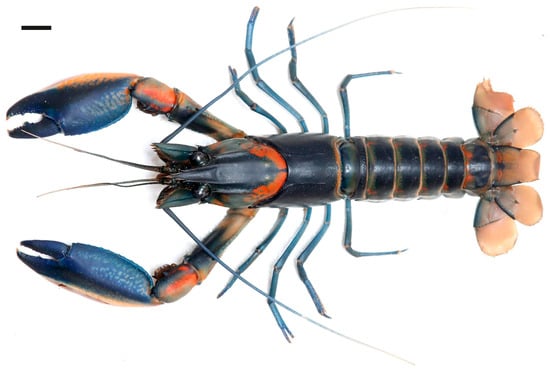
Figure 11.
Cherax bomberai n. sp, holotype male (MZB Cru). Scale bar: 10 mm.
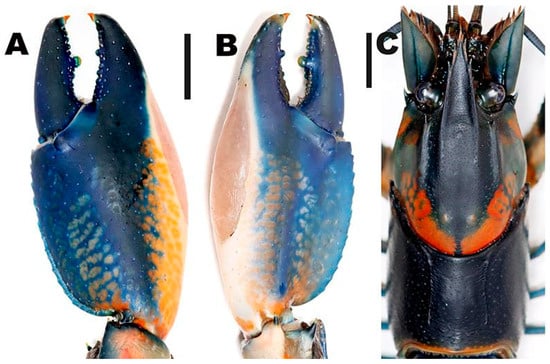
Figure 12.
Right chela and cephalothorax of Cherax bomberai n. sp., holotype male (MZB Cru). (A) Right chela, dorsal view; (B) idem, ventral view; (C) cephalothorax, dorsal view. Scale bar: 10 mm.
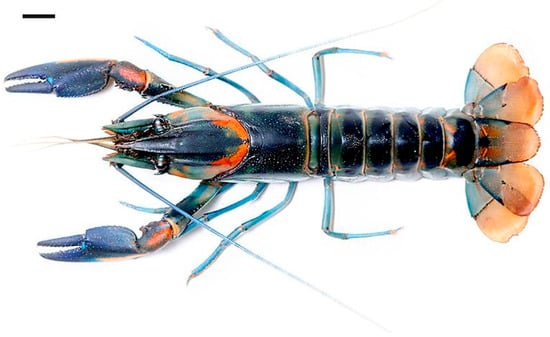
Figure 13.
Cherax bomberai n. sp., allotype female (MZB Cru). Scale bar: 10 mm.
Material examined. Holotype: male (MZB Cru), under rocks, wood, and in debris along banks of an unnamed tributary of the Otauar River drainage in the northeastern part of Fakfak Regency, West Papua, Indonesia. Coll. local people, November 2024. Crayfish were sent to us by KKCrayfish Farm in Jakarta. Allotype: female (MZB Cru), same data as holotype. Paratypes: one male (MZB Cru); one male and one female (ZMB 34711).
Diagnosis. Carapace surface smooth with numerous tiny tubercles posterior to cervical groove on lateral carapace. Eyes large, cornea globular, darkly pigmented. Rostrum lanceolate in shape with excavated margins. Rostral margins with two prominent teeth. Rostral carinae prominent. Postorbital ridges prominent with one acute tubercle at anterior terminus. Prominent uncalcified patch on lateral margin of chelae of adult male white, translucent. Carapace dark blue with orange and greenish stains on the anterior carapace. Chelipeds blue and white with white joints. Fingers with hooked tips. Other walking legs light blue to dark blue. Pleon dark blue with light greenish-blue and creamy transverse bands. Lateral pleura becoming lighter blue-green.
Description of male holotype (Figure 10, Figure 11 and Figure 12). Body and eyes pigmented (Figure 10). Eyes large, cornea globular, darkly pigmented, nearly as long as eyestalk; as broad as eyestalk. Body subovate, slightly compressed laterally. Pleon narrower than cephalothorax (width 23.3 mm and 25.6 mm, respectively). Rostrum (Figure 12C) broad in shape, reaching middle of first antennular peduncle and about 2.6 times as long as wide (width 5.6 mm at base, length 14.5 mm). Margins slightly elevated continuing in rostral carinae on carapace, almost straight in basal part. Acumen with anteriorly orientated spine. Rostral margins with two spines on each side on anterior third of rostrum. Row of dense hairs present on anterior third of rostrum. Rostrum surface pitted with some short, tiny hairs present. Rostral carinae extending as slight elevations posteriorly on carapace, terminating at half of postorbital ridges. Postorbital ridges well developed, terminating in spiniform tubercle anteriorly, fading at half of rostro-cervical part of the carapace posteriorly. Surface between rostral carinae heavily pitted. Postorbital ridges about 1/3 of CL. Cervical and branchiocardiac grooves distinct, not setose; three well-developed spines present at middle part behind cervical groove on lateral sides of one side of carapace, and three well-developed and two smaller ones on the other side. Carapace (58.4 mm) surface smooth; numerous granules posterior to cervical groove on lateral carapace present. Anterior margin strongly produced; rounded upper margin directed inward. Areola smooth, pitted; length 17.9 mm; narrowest width, 9.6 mm. Length of areola 30.6% of total length of carapace (58.4 mm). Scaphocerite, broadest at posterior third, convex in distal part, becoming narrower in basal part; thickened lateral margin terminating in corneous spine, slightly overreaching ultimate segment of antennular peduncle. Left scaphocerite 17.3 mm long and 5.9 mm wide; proximal margins setose. Antennulae and antennae typical for genus. Antennae slightly longer than body. Antennal protopodite smooth, without spine, with row of hairs on inner margin; basicerite with one lateral and one ventral spine. Mouthparts typical for genus. Epistome with subcordiform cephalic lobe anteriorly bearing lanceolate cephalomedian projection constricted at base. Lateral margins of lobe not thickened; each lateral margin with a group of 4–5 and 8–10 small tubercles separated by a smooth region. Central part smooth, not pitted, excavate. First pereopods (Figure 12A,B) subequal in form, subequal in size, right chela slightly gaping, left chela not gaping. Left chelae probably regrown. Right cheliped 49.0 mm long, 10.8 mm high, and 20.7 mm wide. Left chelae 51.9 mm long and 9.6 mm high, 19.4 mm wide, strongly compressed. Fingers shorter than palm (right dactylus 19.4 mm long). Dactylus broad at base (8.2 mm), tapering slightly toward tip. Tip with sharp, corneous, hooked tooth pointing outwards at an angle of 45°. Cutting edge of dactyl with continuous row of 9–10 small granular teeth and one larger granule at mid-length. Ventral and dorsal surface of movable finger smooth with scattered punctuation. Ventral posterior third of cutting edge with dense setae reaching from base to large granule. Fixed finger smooth, scattered punctuation, triangular, merging gradually into palm, ending in sharp, corneous, hooked tooth, parallel to x-axis of finger. Tips of fingers slightly cross when fingers clasp. Upper surface of palm practically smooth, slightly pitted. Fixed finger broader than dactyl at base (8.8 mm). Scattered, short setae present in posterior ventral part of fixed finger, reaching from palm to about one-third of cutting edge. Cutting edge of fixed finger with row of rather small granular teeth at posterior half and one slightly larger at about mid-length.
Outer lateral margin of chelae smooth with white, translucent patch covering about half of lateral margin. Row of 11–12 slightly elevated mesial propodal granules at dorsolateral margin. Dorsolateral margins slightly elevated in posterior two-thirds. Dorsal surface of carpus (16.3 mm) smooth, with excavation in middle part and with two well-developed mesial carpal spines; mesiolateral margin setose. Ventral carpal surface margins slightly elevated and with fovea; inner margin with well-developed ventral carpal spine and a prominent ventromesial carpal spine oriented at an angle of approximately 45°. Merus (29.8 mm) laterally depressed in basal part; surface smooth; prominent dorsal meral spine present. Inner ventrolateral margin smooth; four ventral meral spines present: one at first third, one at mid-length, other at tip of anterior part, and fourth on distal ventrolateral inner margin. Ischium (15.1 mm) smooth with three small spines at ventrolateral inner margin.
Second pereopods reaching anteriorly to approximately mid-length of scaphocerite. Propodus (12.1 mm) and dactylus (6.6 mm) slightly longer than fixed finger (5.3 mm), of same height. Few scattered, short setae present on dactyl and fixed finger. Cutting edge of dactyl and propodus with row of dense, short setae. Carpus (9.5 mm), smooth, slightly pitted. Merus 16.7 mm. Ischium (8.1 mm) about half as long as merus.
Third pereopods overreaching second pereopods to mid-length of carpus. Fingers shorter than palm. Fourth pereopods reaching distal margin of scaphocerite. Dactylus (5.5 mm) with corneous tip; short setae present. Propodus (14.8 mm) about three times as long as dactylus, somewhat flattened, carrying many stiff setae anterior part. Carpus (13.8 mm) about 2.5 times as long as dactylus. Merus 19.8 mm. Fifth pereopods similar to fourth, slightly shorter. Dorsal surface of pleon smooth, with scattered pits; abdominal segments (1–5) with short setae present on caudal margins of segment. Pleon length 69.1 mm. Telson with posterolateral spines; dense short setae present in posterior third; posterior margins setose. Uropodal protopod with two distal spines on mesial lobe. Exopod of uropod with transverse row of posteriorly directed diminutive spines ending in one more prominent spine, posteriorly directed on outer margin of mesial lobe. Terminal half of exopod with small spines and short hairs, slightly corrugated. Endopod of uropod smooth. Short, scattered hairs present on posterior third of dorsal exopod. Posterolateral spine on outer margin present. Second spine on medial dorsal surface present, directed posteriorly. Total length 127.5 mm.
Description of female allotype (Figure 13). Chela of first pereopods equal, 2.9 times as long as broad (38.6 mm and 13.3 mm, respectively). Mesial margin of palm slightly elevated, forming slender serrated ridge with row of 17–18 small granular teeth. Cutting edge of dactylus with 12 rather small granular teeth, 1 slightly bigger. Cutting edge of fixed finger with 10 granules. Small, scattered, short setae visible along ventral cutting edges of chelae, denser and longer in ventral posterior area. Tips of fingers slightly cross when fingers clasp, slightly gaping. No soft patch present. Pleon as broad as cephalothorax (width 25.1 mm and 25 mm, respectively). Rostrum broad in shape, reaching the middle of first antennular peduncle and about 2.5 times as long as wide (width 6.7 mm at base, length 15.6 mm). Margins slightly elevated, continuing in rostral carinae on carapace, almost straight in basal part, distal third, pointing upwards at an angle of approximately 45°. Acumen with anteriorly orientated spine. Few scattered hairs present on anterior third of rostrum. Rostral carinae extending as slight elevations posteriorly on carapace, terminating at half of postorbital ridges. Postorbital ridges well developed, terminating in spiniform tubercle anteriorly, fading at half of occipital carapace length, posteriorly. Postorbital ridges about 1/4 of CL. Cervical and branchiocardiac grooves distinct, not setose; four well-developed spines present at middle part behind cervical groove on lateral sides of carapace. Carapace surface smooth; numerous tiny granules posterior to cervical groove on lateral carapace present. Anterior margin strongly produced; rounded upper margin directed inward. Areola smooth, pitted; length 18.1 mm; narrowest width 10.7 mm. Length of areola 29.9% of total length of carapace (60.6 mm). Pleon length 74.5 mm. Same color pattern as in males. Total length 135.1 mm.
Size. The variation in size in the studied sample of C. bomberai n. sp. is given in Table 2, which also provides comparisons with all other newly described species.
Color. The living animals (Figure 10A,B) are colored as follows. Individuals of Cherax bomberai n. sp. usually have blue and white chelipeds with white joints. Prominent uncalcified patch on lateral margin of chelae of adult male, white, translucent. Carapace dark blue with orange and greenish stains on the anterior carapace. Fingers with hooked orange tips. Other walking legs light blue to dark blue. Pleon dark blue with light greenish-blue and creamy transverse bands. Lateral pleura becoming lighter blue-green. Females: same color as males with smaller chelae. Females do not show the creamy white soft patch.
Molecular phylogenetic results. Cherax bomberai n. sp. forms a highly supported, distinct clade that is the sister species of C. arguni n. sp. with high support; both species are, in turn, sister to a moderately supported clade comprising C. kaimana n. sp. and C. farhadii n. sp. (Figure 5). The clade comprising these four species is highly supported and very distinct; it is sister group to a clade comprising ten species, including, e.g., C. veritas n. sp. and C. pulcher, but this relationship is weakly supported. Cherax bomberai n. sp. is well isolated from C. arguni n. sp. and C. kaimana n. sp./C. farhadii n. sp., with a sequence divergence (p-distance) of 1.7–1.9% (16S)/7.8% (COI) and 2.5–3.6%/12.0% (COI; C. kaimana n. sp. only), respectively, supporting the morphology-based description of C. bomberai as a new species.
Systematic position. Cherax bomberai n. sp. belongs to the northern species group lineage, now consisting of 35 species (please see the respective section for C. nigli n. sp. below for details.)
Systematic remarks. In comparison to all species of the northern group, the new species, Cherax bomberai n. sp., is morphologically and genetically most similar to C. arguni n. sp., to C. farhadii n. sp., and to C. kaimana n. sp. Cherax bomberai n. sp. may be easily distinguished from these three species by the coloration and pattern of live individuals, by the shape of the chelae, by the shape of the rostrum, and by DNA barcoding (please see the respective section for C. arguni n. sp. above for details (Figure 5, Figure 6, Figure 7 and Figure 8)).
Ecology. Crayfish hide under rocks, wood, and among roots and in debris along banks of an unnamed tributary of the Otauar River drainage in the northeastern part of the Fakfak Regency, West Papua, Indonesia. To improve the knowledge of the distribution of this species, more field surveys will be necessary.
Distribution (Figure 9). Cherax bomberai n. sp. has so far only been found in a tributary of the Otauar River drainage in the northeastern part of the Fakfak Regency. It likely occurs at least throughout the entire catchment.
Common name. As the common name for this crayfish, we propose the Devil Crayfish, as it is already available under this name in the pet trade.
Etymology. The specific name derives from the origin (occurrence) of this population on the Bomberai Peninsula. It is proposed as a noun in apposition.
Cherax doberai n. sp.
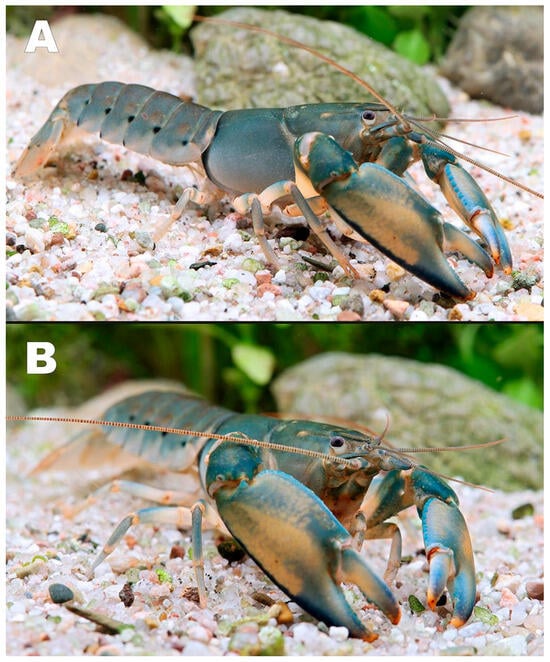
Figure 14.
Cherax doberai n. sp. (A) Holotype male (MZB Cru), unnamed Creek in the Teluk Bintuni Regency, West Papua, Indonesia. (B) Idem frontal view.
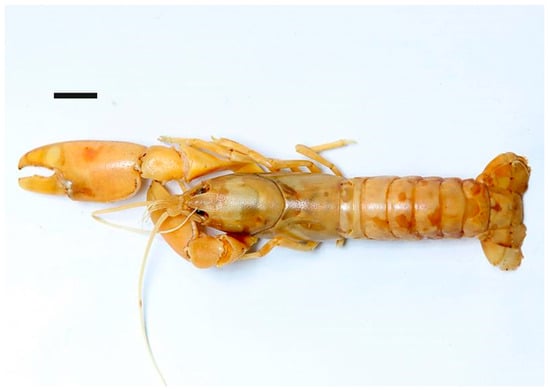
Figure 15.
Cherax doberai n. sp., holotype male (MZB Cru). Scale bar: 10 mm.
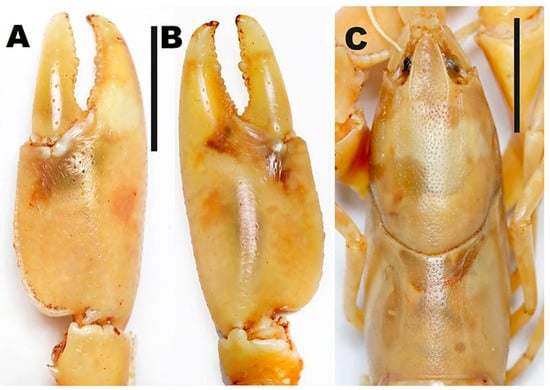
Figure 16.
Right chela and cephalothorax of Cherax doberai n. sp., holotype male (MZB Cru). (A) Right chela, dorsal view; (B) idem, ventral view; (C) cephalothorax, dorsal view. Scale bar: 10 mm.
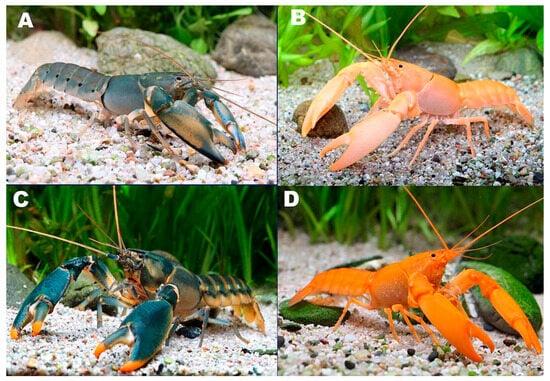
Figure 17.
Coloration comparison of Cherax doberai n. sp. (A) with C. holthuisi (B), C. snowden (C), and the orange form of C. snowden from Sasnek, Distrik Sawiat, South Sorong Regency (D).
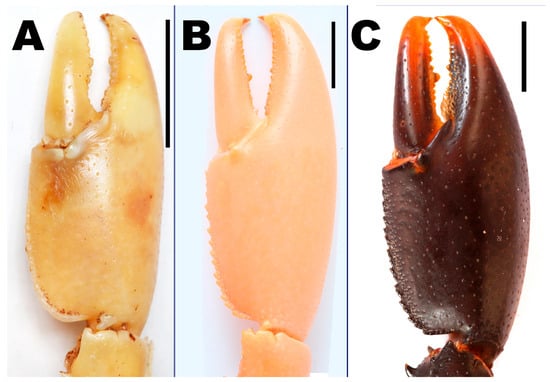
Figure 18.
Chelae comparison of right chelae (dorsal view) of Cherax doberai n. sp. (A) with C. holthuisi (B) and C. snowden (C).
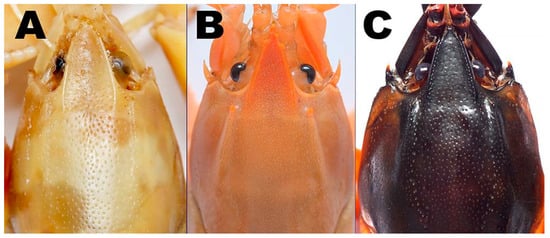
Figure 19.
Rostrum comparison of Cherax doberai n. sp. (A) with C. holthuisi (B) and C. snowden (C).
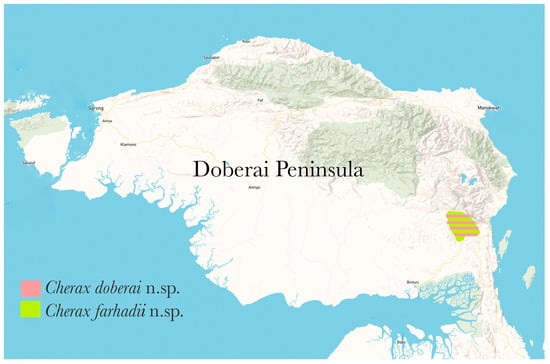
Figure 20.
The Doberai Peninsula, West Papua, Indonesia, with the distribution of Cherax doberai n. sp. and Cherax farhadii n. sp. in the Teluk Bintuni Regency, West Papua, Indonesia.
Material examined. Holotype: male (MZB Cru), under rocks, wood, and among roots and in debris along banks of an unnamed creek in the Teluk Bintuni Regency, West Papua, Indonesia. Coll. local people, May 2019. The specimen was sent to Aquarium Dietzenbach by Maju Aquarium.
Diagnosis. Carapace surface smooth. Eyes rather small, pigmented. Rostrum lanceolate in shape. No teeth or spines on marginal edges, just two indentations on one side of the rostrum, and three on the other. Marginal edge in the anterior quarter with two granules on the left side of rostrum and three on the other. Rostral carinae weakly developed. Chelipeds blueish-grey with some creamy yellow-white with white joints. Fingers with weakly developed hooked tips. Other walking legs creamy white with some blueish-grey. Lateral pleura becoming creamy blue-grey.
Description of male holotype (Figure 14, Figure 15 and Figure 16). Body and eyes pigmented (Figure 14). Eyes rather small, cornea slightly broader than eyestalk. Body subovate, slightly compressed laterally. Pleon slightly narrower than cephalothorax (width 11.7 mm and 12.3 mm, respectively). Rostrum (Figure 16C) broad in shape, reaching end of first antennular peduncle and about 1.4 times as long as wide (width 3.6 mm at base, length 5.2 mm). Margins slightly elevated, continuing in rostral carinae on carapace, almost straight in basal part. Acumen with anteriorly orientated granule. Marginal edge in anterior quarter with two granules on left side of rostrum and three on the other. Postorbital ridges weakly developed, with one small tubercle at anterior terminus fading at half of occipital carapace length. Surface between rostral carinae heavily pitted. Postorbital ridges about 1/4 of carapace length. Cervical and branchiocardiac grooves distinct, not setose. No granules or spines present at middle part behind cervical groove on lateral sides of carapace. Carapace (28.6 mm) surface smooth. Anterior margin strongly produced; rounded upper margin directed inward. Areola smooth, pitted, small; length, 10.3 mm; narrowest width, 4.5 mm. Length of areola 36.0% of total length of carapace (28.6 mm). Scaphocerite, broadest at posterior third, convex in distal part, becoming narrower in basal part; thickened lateral margin terminating in corneous spine, reaching ultimate segment of antennular peduncle. Left scaphocerite 4.3 mm long and 1.9 mm wide. Proximal margins setose. Antennulae and antennae typical for genus. Antennae about as long as body. Antennal protopodite smooth, without spine; basicerite with one small ventral spine. Mouthparts typical for genus. Epistome with subcordiform cephalic lobe anteriorly bearing triangular lanceolate cephalomedian projection constricted at base. Lateral margins of lobe not thickened; each lateral margin with group of 5–7 very small tubercles separated by smooth region. Central part smooth, not pitted, excavate. First pereopods (Figure 16A,B) equal in form, subequal in size, chela slightly gaping. Left cheliped 20.8 mm long, 5.2 mm high, and 8.8 mm wide. Right chelae 25.8 mm long, 7.0 mm high, and 11.2 mm wide, strongly compressed. Fingers shorter than palm (left dactylus 10.6 mm long). Dactylus broad at base (4.6 mm), tapering slightly toward tip. Tip with corneous tooth pointing outwards at an angle of 45°. Cutting edge of dactyl with continuous row of 10 small granular teeth and 1 slightly larger granule. Ventral and dorsal surface of movable finger smooth with scattered punctuation. Fixed finger smooth, scattered punctuation, triangular, merging gradually into palm, ending in corneous, hooked tooth, parallel to x-axis of finger. Tips of fingers slightly cross when fingers clasp. Upper surface of palm practically smooth, slightly pitted, more densely pitted at margins. Fixed finger broader than dactyl at base (5.6 mm). Scattered, short setae present in posterior ventral part of fixed finger, reaching from palm to about one-third of cutting edge. Cutting edge of fixed finger with row of 12 rather small granular teeth at posterior half. Outer lateral margin of chelae smooth, no patch present. Row of 4–5 small mesial propodal granules at dorsolateral margin. Dorsolateral margins slightly elevated in the posterior half. Dorsal surface of carpus (8.7 mm) smooth, with slight excavation in middle part and with one weakly developed mesial carpal spine. Ventral carpal surface margins slightly elevated, not setose, and with fovea; inner margin with weakly developed ventral carpal spine and ventromesial carpal spine oriented at an angle of approximately 45°. Merus (13.5 mm) laterally depressed in basal part; surface smooth; small dorsal meral spine present. Inner ventrolateral margin smooth; two ventral meral spines present: one at first third, one at mid-length, other at tip of anterior part. Ischium (8.8 mm) smooth with a row of six small tubercles at ventrolateral outer margin.
Second pereopods reaching anteriorly to tip of scaphocerite. Propodus (7.3 mm) and dactylus (3.6 mm) slightly longer than fixed finger (2.6 mm), of same height. Cutting edge of dactyl and propodus with row of dense, short setae. Carpus (4.9 mm), smooth, slightly pitted. Merus 10.2 mm. Ischium (4.7 mm) about half as long as merus. Third pereopods overreaching second pereopods to mid-length of carpus. Fingers shorter than palm. Fourth pereopods reaching distal margin of scaphocerite. Dactylus (2.5 mm) with corneous tip; no setae present. Propodus (7.1 mm) more than two times as long as dactylus, somewhat flattened, carrying many stiff setae on lower margin. Carpus (4.8 mm) about twice as long as dactylus. Merus (9.0 mm). Fifth pereopods similar to fourth, slightly shorter. Dorsal surface of pleon smooth, with scattered pits; abdominal segments (1–5) with short setae present on caudal margins of segment. Pleon length 36.1 mm. Telson with posterolateral tiny spines; dense short setae present in posterior third; posterior margins setose. Uropodal protopod with two small distal spines on mesial lobe. Exopod of uropod with transverse row of posteriorly directed diminutive spines ending in small spine, posteriorly directed on outer margin of mesial lobe. Terminal half of exopod with small spines and short hairs, slightly corrugated. Endopod of uropod smooth. Short, scattered hairs present on posterior third of dorsal exopod. Posterolateral spine on outer margin present. Second spine on medial dorsal surface present, directed posteriorly.
Color. The living animals (Figure 14A,B) are colored as follows. The individual male of Cherax doberai n. sp. has blueish grey with some creamy yellow chelipeds with white joints. Fingers with weakly developed orange hooked tips. Outer lateral margin of chelae with a dark blue band. Dorsolateral margins light blue. Other walking legs creamy white with some blueish grey. Five small and dark blue spots on both sides of lateral pleura. Lateral pleura becoming creamy blue-grey. Telson fan light creamy.
Molecular phylogenetic results. Cherax doberai n. sp. is a distinct lineage with uncertain affinities (Figure 5). Cherax doberai n. sp. is well isolated from all other Cherax species included in our analyses, with an overall minimum sequence divergence (p-distance, 16S) of 5.3% from both C. monticola and C. nigli n. sp., supporting the morphology-based description of C. doberai as a new species.
Systematic position. C. doberai n. sp. belongs to the northern species group lineage, now consisting of 35 species (please see the respective section for C. nigli n. sp. below for details).
Systematic remarks. In comparison to all species of the northern group, Cherax doberai n. sp. is morphologically most similar to C. holthuisi and C. snowden. Cherax doberai n. sp. may be easily distinguished from both species by the coloration and pattern of live individuals (Figure 17), by the shape of the chelae (Figure 18), by the shape of the rostrum (Figure 19), and by DNA barcoding (Figure 5).
Coloration comparison (Figure 17). The individual male of Cherax doberai n. sp. (Figure 17A) has blueish grey with some creamy yellow chelipeds with white joints. Fingers with weakly developed orange hooked tips. Outer lateral margin of chelae with a dark blue band. Dorsolateral margins light blue. Other walking legs creamy white with some blueish grey. Pleon blue-grey. Individuals of C. holthuisi (Figure 17B) from Lake Aitinjo are usually creamy orange; rarely, light blue animals appear in the shipments from the exporter as well. Individuals from Lake Ajamaru are usually brown to greenish black. The living animals of C. snowden (Figure 17C) are colored as follows. Chelae dark green to light green or greenish-gray, distal part of the lower margin cream to orange. Tips of chelae orange. Cephalothorax dark green, light green, brown-green, sometimes blueish-green, fading ventrally to cream, beige, or orange. Pleon same color as cephalothorax with transverse orange bands, pleura creamy to orange, with a black, brown, or dark green band. Walking legs from dark green to blueish-gray or creamy yellow, sometimes brown-yellow. Distal margin of tail-fan cream to orange. Bright orange animals of C. snowden (Figure 17D) are known from Sasnek, Distrik Sawiat, South Sorong Regency.
Chelae comparison (Figure 18). In C. doberai n. sp. (Figure 18A), the dorsolateral margins have a row of poorly developed, slightly elevated mesial propodal granules at dorsolateral margin, in contrast to 15–16 well-developed propodal granules in both C. holthuisi (Figure 18B) and C. snowden (Figure 18C). In C. doberai n. sp., the chelae are 2.3 times longer than the movable finger, while in C. holthuisi the chelae are 2.4 times longer, and in C. snowden 2.5 times longer than the movable finger. In C. doberai n. sp., the chelae are 2.3 times as long as broad, in C. holthuisi 2.4 times, and in C. snowden 2.7 times as long as broad.
Rostrum comparison (Figure 19A–C). The rostrum of Cherax doberai n. sp. (Figure 19A) is broad at the base, and lanceolate shaped. The rostrum of C. holthuisi (Figure 19B) is rather straight and triangular shaped, while the rostrum of C. snowden (Figure 19C) is triangular shaped but broader at the base. Rostral margins of C. doberai n. sp. with two granules on one side and three on the other side on anterior fifth of rostrum, while C. holthuisi and C. snowden both have one tubercal spine on one side and two on the other. The rostrum of C. doberai n. sp. is 1.2 times longer than broad, of C. holthuisi 1.6 times longer, and of C. snowden 1.4 times longer than broad. In C. doberai n. sp., the rostral carinae extend beyond the anterior postorbital ridges, while in C. holthuisi and C. snowden the rostral carinae are just reaching the anterior postorbital ridges.
Ecology. The habitat of this species is not known. The catchers are keeping the exact location a secret.
Distribution (Figure 20). Bird’s Head Peninsula, Teluk Bintuni Regency, West Papua.
Common name. As the common name for this crayfish, we propose the Doberai Blue Crayfish.
Etymology. This species is named after the Bird’s Head Peninsula or Doberai Peninsula (Semenanjung Kepala Burung/Doberai), the large peninsula that makes up the northwest portion of the island of New Guinea, where this species was found. It is proposed as a noun in apposition.
Cherax farhadii n. sp.
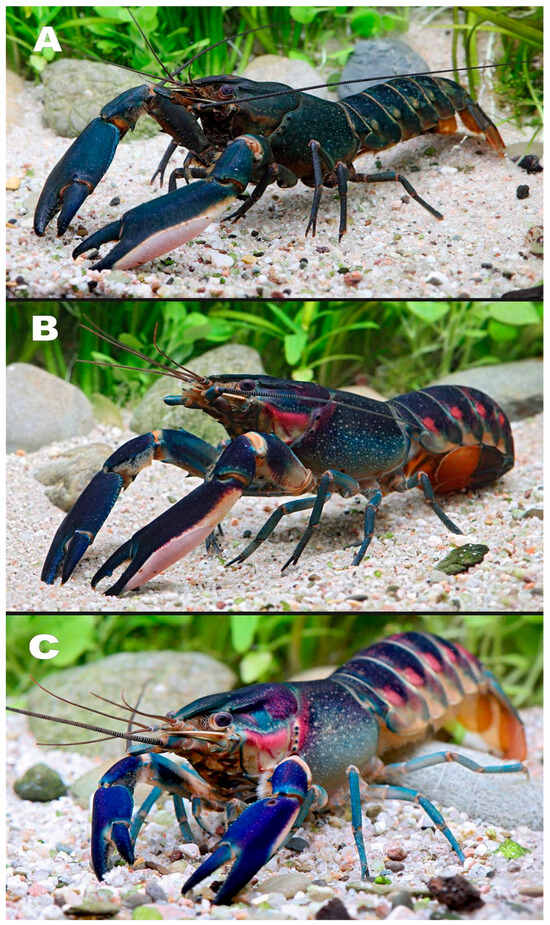
Figure 21.
Cherax farhadii n. sp. (A) Holotype male (MZB Cru), from a nameless creek in the Teluk Bintuni Regency, West Papua, Indonesia. (B) Paratype (MZB Cru), same data as holotype. (C) Allotype (MZB Cru), same data as holotype.
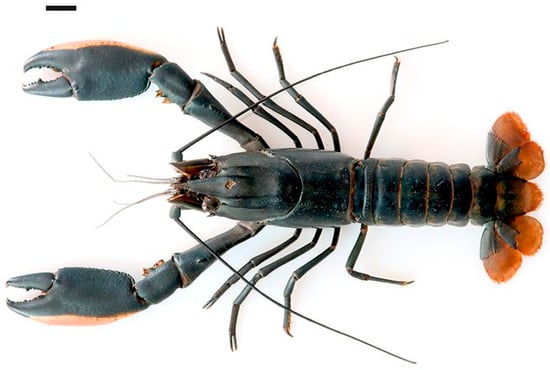
Figure 22.
Cherax farhadii n. sp., holotype male (MZB Cru). Scale bar: 10 mm.
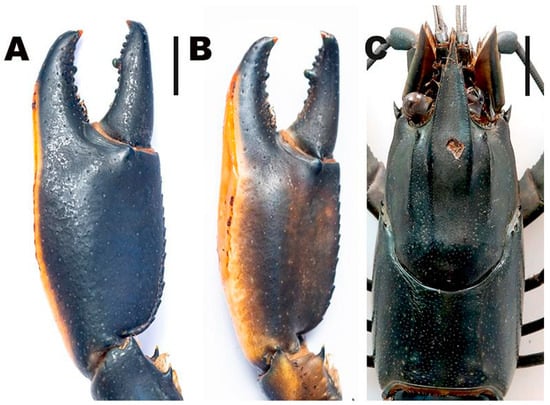
Figure 23.
Right chelae and cephalothorax of Cherax farhadii n. sp., holotype male (MZB Cru). (A) Left chela, dorsal view; (B) idem, ventral view; (C) cephalothorax, dorsal view. Scale bar: 10 mm.
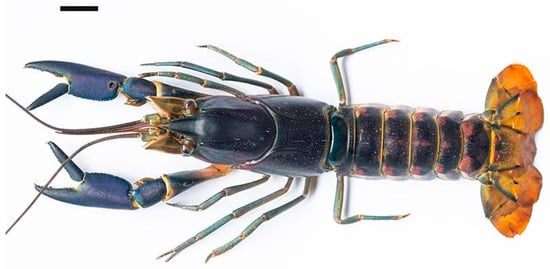
Figure 24.
Cherax farhadii n. sp., allotype female (MZB Cru). Scale bar: 10 mm.
Material examined. Holotype: male (MZB Cru), under rocks, wood, and among roots and in debris along banks of a nameless tributary unnamed creek in the Teluk Bintuni Regency, West Papua, Indonesia. Coll. local people, May 2019. Crayfish were sent to Aquarium Dietzenbach by Maju Aquarium, Jakarta. Allotype: female (MZB Cru), same data as holotype. Paratypes: two males and one female (MZB Cru); three males and one female (ZMB 34712); same data as holotype.
Diagnosis. Carapace surface smooth. Eyes large, pigmented. Cornea slightly broader than eyestalk. Rostrum lanceolate in shape with excavated margins. Rostral margins with two prominent teeth on one side and three on the other. Rostral carinae prominent. Postorbital ridges prominent with one acute tubercle at anterior terminus. Prominent uncalcified patch on lateral margin of chelae of adult male, white, translucent. Propodal cutting edge with row of small granules and one larger tubercle. Chelipeds blue and white with white joints. Fingers with hooked tips. Other walking legs light blue to dark blue. Pleon dark blue with creamy transverse bands. Lateral pleura becomes lighter green or blue to creamy. Some animals with pink lateral dot on five segments, others with yellowish to greenish dot. Several animals, usually the adult ones, show a dent on the epigastric region between the rostral carinae from the rostrum end to the end of the carinae. This was not observed by other Cherax described from Papua.
Description of male holotype (Figure 21, Figure 22 and Figure 23). Body and eyes pigmented (Figure 21). Eyes not reduced. Cornea slightly broader than eyestalk. Body subovate, slightly compressed laterally. Pleon narrower than cephalothorax (width 22.7 mm and 25.9 mm, respectively). Rostrum (Figure 23C) broad in shape, overreaching first antennular peduncle and about 2.3 times as long as wide (width 6.9 mm at base, length 15.9 mm). Margins elevated, continuing in rostral carinae on carapace, almost straight in basal part. Acumen with anteriorly orientated spine. Rostral margins with two spines on one side and three on the other side on anterior third of rostrum. Row of dense hairs present on anterior third of rostrum. Rostral carinae extending as slight elevations posteriorly on carapace terminating at half of postorbital ridges. Postorbital ridges well developed, terminating in spiniform tubercle anteriorly, fading at half of occipital carapace length, posteriorly. Surface between rostral carinae pitted. Postorbital ridges about 1/4 of CL. Dent on dorsal carapace between rostral carinae from rostrum end to end of carinae present. Cervical and branchiocardiac grooves distinct, not setose; three spines present at middle part behind cervical groove on lateral sides of carapace on one side and four on the other. Carapace (59.9 mm) surface smooth; anterior margin strongly produced; rounded upper margin directed inward. Areola smooth, pitted. Length, 17.5 mm; narrowest width, 10.8 mm. Length of areola 29.2% of total length of carapace (59.9 mm). Scaphocerite, broadest at posterior third, convex in distal part, becoming narrower in basal part; thickened lateral margin terminating in corneous spine, slightly overreaching ultimate segment of antennular peduncle. Left scaphocerite 10.3 mm long and 5.2 mm wide; proximal margins setose. Antennulae and antennae typical for genus. Antennae longer than body. Antennal protopodite smooth, without spine, with row of hairs on inner margin; basicerite with one lateral and one ventral spine. Mouthparts typical for genus. Epistome with subcordiform cephalic lobe anteriorly bearing rounded lanceolate cephalomedian projection constricted at base. Lateral margins of lobe not thickened; each lateral margin with group of 5–6 small tubercles separated by smooth region. Central part smooth, not pitted, excavate. First pereopods (Figure 23A,B) equal in form, chela slightly gaping. Left cheliped 59.6 mm long, 12.6 mm high, and 26.5 mm wide. Right chelae 50.8 mm long and 12 mm high, 19.1 mm wide, strongly compressed. Fingers shorter than palm (right dactylus 18.4 mm long). Dactylus broad at base (7.0 mm), tapering slightly toward tip. Tip with sharp, corneous, hooked tooth pointing outwards at an angle of 45°. Cutting edge of dactyl with continuous row of 6–7 small granular teeth and 1 larger granule. Ventral and dorsal surface of movable finger smooth with scattered punctuation. Ventral cutting edge with few short, scattered setae on base. Fixed finger smooth, scattered punctuation, triangular, merging gradually into palm, ending in sharp, corneous, hooked tooth, parallel to x-axis of finger. Tips of fingers slightly cross when fingers clasp. Upper surface of palm practically smooth, slightly pitted, more densely pitted at margins. Fixed finger broader than dactyl at base (8.5 mm). Scattered, short setae present in posterior ventral part of fixed finger, reaching from palm to about one-third of cutting edge. Cutting edge of fixed finger with row of rather small granular teeth and one slightly bigger one.
Outer lateral margin of chelae smooth with white, translucent patch covering about two-thirds of lateral margin. Row of 11–12 small slightly elevated mesial propodal granules. Dorsolateral margins slightly elevated in posterior half. Dorsal surface of carpus (17.7 mm) smooth, with slight excavation in middle part and with two well-developed mesial carpal spines. Ventral carpal surface margins slightly elevated, setose, and with fovea; inner margin with well-developed ventral carpal spine and a prominent ventromesial carpal spine oriented at an angle of approximately 45°. Merus (27.78 mm) laterally depressed in basal part; surface smooth; prominent dorsal meral spine present at anterior third; inner ventrolateral margin smooth; four ventral meral spines present: one at first third, one at mid-length, another at tip of anterior part, and fourth on distal ventrolateral inner margin. Ischium (14.7 mm) smooth with 1 small spine and 3–4 granules at ventrolateral inner margin.
Second pereopods reaching anteriorly to approximately anterior third of scaphocerite. Propodus (11.9 mm) and dactylus (6.5 mm) slightly longer than fixed finger (6.1 mm), of same height. Few scattered, short setae present on dactyl and fixed finger. Cutting edge of dactylus and propodus with row of dense, short setae. Carpus (14.6 mm), smooth, slightly pitted. Merus 17.5 mm. Ischium (9.1 mm) about half as long as merus.
Third pereopods overreaching second pereopods to mid-length of carpus. Fingers shorter than palm. Dactylus (7.1 mm) with corneous tip; short, scattered hairs present in posteriour half. Propodus (15.4 mm) about two times as long as dactylus, somewhat flattened. Carpus (14.9 mm) about twice as long as dactylus. Merus 15.6 mm. Fourth pereopods reaching distal margin of scaphocerite. Dactylus (3.9 mm) with corneous tip. Short, scattered setae present. Propodus (11.9 mm) about three times as long as dactylus, somewhat flattened, carrying scattered stiff setae on lower margin. Carpus (8.1 mm) about twice as long as dactylus. Merus 16.3 mm. Fifth pereopods similar to fourth, shorter. Dorsal surface of pleon smooth, pitted; abdominal segments (1–5) with short creamy colored setae present on caudal margins of segment. Pleon length 64.4 mm. Telson with posterolateral spines; dense short setae present in posterior third; posterior margins setose. Uropodal protopod with two distal spines on mesial lobe. Exopod of uropod with transverse row of posteriorly directed diminutive spines ending in one more prominent spine, posteriorly directed on outer margin of mesial lobe. Terminal half of exopod with small spines and short hairs, slightly corrugated. Endopod of uropod smooth. Short, scattered hairs present on posterior third of dorsal exopod. Posterolateral spine on outer margin present. Second spine on medial dorsal surface present, directed posteriorly. Total length 124.3 mm.
Description of female allotype (Figure 24). Chela of first pereopods equal, 2.9 times as long as broad (29.1 mm and 9.8 mm, respectively). Mesial margin of palm slightly elevated, forming slender serrated ridge with row of 9–10 small granular teeth. Cutting edge of dactylus with 6–9 rather small granular teeth, 1 slightly bigger. Cutting edge of fixed finger with 7–8 small granules, 1 slightly bigger. Small scattered, short setae visible along ventral cutting edges of chelae, denser and longer in ventral posterior area. Tips of fingers slightly cross when fingers clasp, not gaping. No soft patch present. Pleon narrower than cephalothorax (width 21.7 mm and 22.4 mm, respectively). Rostrum broad in shape, reaching middle of first antennular peduncle and about 2.1 times as long as wide (width 6.3 mm at base, length 13.8 mm); margins elevated, continuing in rostral carinae on carapace, almost straight in basal part, distal third, pointing upwards at an angle of approximately 45°. Acumen with anteriorly orientated spine. Short, dense hairs present on anterior third of rostrum. Rostral carinae extending as slight elevations posteriorly on carapace, terminating at half of postorbital ridges. Postorbital ridges well developed, terminating in spiniform tubercle anteriorly, fading at half of occipital carapace length, posteriorly. Slight dent on epigastric region between rostral carinae from rostrum end to end of carinae. Postorbital ridges about 1/4 of CL. Cervical and branchiocardiac grooves distinct, short, scattered hairs present at lateral mid part; three small spines present on one side and four on the other at middle part behind cervical groove on lateral sides of carapace. Carapace surface smooth; anterior margin strongly produced; rounded upper margin directed inward. Areola smooth, pitted; length, 15.2 mm; narrowest width, 9.3 mm. Length of areola 30.2% of total length of carapace (50.3 mm). Same color pattern as in males. Total length 112.9 mm.
Size. The variation in size in the studied sample of C. farhadii n. sp. is given in Table 2, which also provides comparisons with all other newly described species.
Color. The living animals (Figure 21A–C) are colored as follows. Individuals of Cherax farhadii n. sp. usually have blue chelipeds with white joints. Uncalcified patch on lateral margin of chelae, white, translucent. Fingers with hooked orange tips. Carapace dark blue or greenish-blue, becoming lighter laterally. Numerous creamy to white small spots on lateral and dorsal carapace. Walking legs light blue to dark blue. Pleon dark blue with creamy transverse bands. Lateral pleura becoming lighter green or blue to creamy. Some animals with a pink lateral dot on five segments, others with yellowish to greenish dot. Females: same color as males with smaller chelae. Females do not show the creamy white soft patch.
Molecular phylogenetic results. Cherax farhadii n. sp. forms a highly supported, distinct clade that is a sister species to C. kaimana n. sp. with mediocre support; both species are, in turn, sister to a highly supported clade comprising C. arguni n. sp. and C. bomberai n. sp. (Figure 5). The clade comprising these four species is highly supported and very distinct; it is sister group to a clade comprising ten species, including, e.g., C. veritas n. sp. and C. pulcher, but this relationship is weakly supported. Cherax farhadii n. sp. is well isolated from C. kaimana n. sp. and C. arguni n. sp./C. bomberai n. sp., with a sequence divergence (p-distance, 16S) of 2.3% and 3.2–3.8%, respectively, supporting the morphology-based description of C. farhadii as a new species.
Systematic position. C. farhadii n. sp. belongs to the northern species group lineage, now consisting of 35 species (please see the respective section for C. nigli n. sp. below for details).
Systematic remarks. In comparison to all species of the northern group, the new species, Cherax farhadii n. sp., is morphologically and genetically most similar to C. arguni n. sp., to C. bomberai n. sp., and to C. kaimana n. sp. Cherax farhadii n. sp. may be easily distinguished from these three species by the coloration and pattern of live individuals, by the shape of the chelae, by the shape of the rostrum, and by DNA barcoding (please see the respective section for C. arguni n. sp. above for details (Figure 5, Figure 6, Figure 7 and Figure 8)).
Ecology. The habitat of this species is not known. The catchers are keeping the exact location a secret.
Distribution (Figure 20). Bird’s Head Peninsula, Teluk Bintuni Regency.
Common name. As the common name for this crayfish, we propose Red Cheek Crayfish, as it is already available under this name in the pet trade.
Etymology. Cherax farhadii n. sp. is named after Farschad Farhadi, a freshwater invertebrate enthusiast and friend of the first author. With this work, the first author would like to thank him for all his years of support.
Cherax kaimanan. sp.
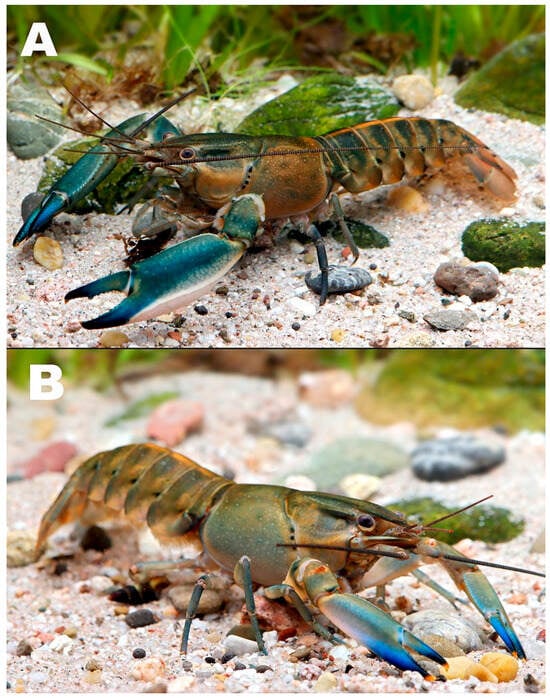
Figure 25.
Cherax kaimana n. sp. (A) Holotype male (MZB Cru), unnamed creek close to Rafa, Kaimana Regency, West Papua, Indonesia. (B) Allotype (MZB Cru), same data as holotype.
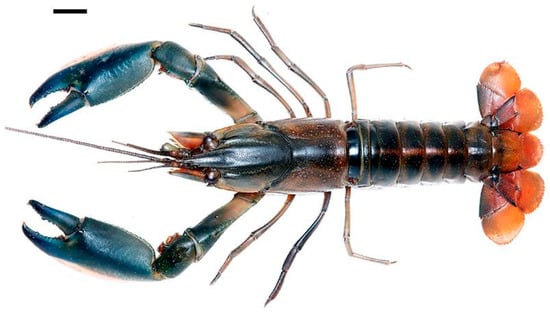
Figure 26.
Cherax kaimana n. sp., holotype male (MZB Cru). Scale bar: 10 mm.
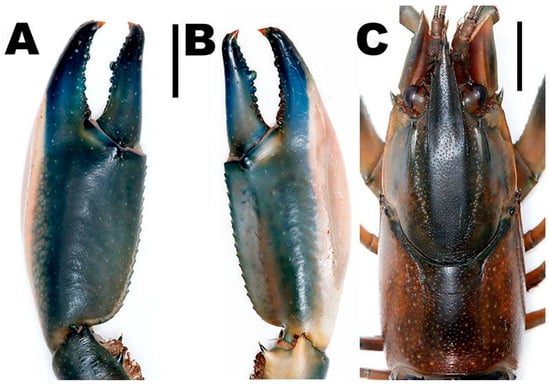
Figure 27.
Left chela and cephalothorax of Cherax kaimana n. sp., holotype male (MZB Cru). (A) Left chela, dorsal view; (B) idem, ventral view; (C) cephalothorax, dorsal view. Scale bar: 10 mm.

Figure 28.
Cherax kaimana n. sp., allotype female (MZB Cru). Scale bar: 10 mm.
Material examined. Holotype: male (MZB Cru), under rocks, wood, and among roots and in debris along banks of an unnamed tributary close to Rafa Village in the northern part of Kaimana Regency, West Papua, Indonesia. Coll. local people, November 2024. Crayfish were sent to us by KKCrayfish Farm in Jakarta. Allotype: female (MZB Cru), same data as holotype. Paratypes: one male and one female (ZMB 34713); same data as holotype.
Diagnosis. Carapace surface smooth, eyes large, pigmented. Cornea as broad as eyestalk. Rostrum lanceolate in shape with excavated margins. Rostral margins with two prominent teeth on one side and three on the other. Rostral carinae prominent. Postorbital ridges prominent with one acute tubercle at anterior terminus. Prominent uncalcified patch on lateral margin of chelae of adult male, white, translucent. Propodal cutting edge with row of small granules and one larger tubercle. Chelipeds blueish-grey and green with white joints. Fingers with hooked tips. Other walking legs blue-grey. Pleon greenish-orange with orange line lengthwise. Lateral pleura becoming lighter greenish-orange.
Description of male holotype (Figure 25, Figure 26 and Figure 27). Body and eyes pigmented (Figure 25). Eyes slightly reduced. Cornea globular, darkly pigmented, nearly as long as eyestalk; as broad as eyestalk. Body subovate, slightly compressed laterally. Pleon narrower than cephalothorax (width 20.4 mm and 21.3 mm, respectively). Rostrum (Figure 27C) broad in shape, reaching about anterior end of first antennular peduncle and about 2.3 times as long as wide (width 5.2 mm at base, length 12.0 mm). Margins slightly elevated, continuing in rostral carinae on carapace, almost straight in basal part. Acumen with anteriorly oriented spine. Rostral margins with two spines on one side and three on the other side on anterior third of rostrum. Few scattered hairs present on anterior third of rostrum. Rostrum surface pitted with short, scattered hairs. Rostral carinae extending as slight elevations posteriorly on carapace, terminating at half of postorbital ridges. Postorbital ridges well developed, terminating in spiniform tubercle anteriorly, fading at half of occipital carapace length, posteriorly. Surface between rostral carinae heavily pitted. Postorbital ridges about 1/5 of CL. Cervical and branchiocardiac grooves distinct, not setose; 3–4 small spines present at middle part behind cervical groove on lateral sides of carapace. Carapace (51.5 mm) surface smooth; anterior margin strongly produced; rounded upper margin directed inward. Areola smooth, pitted; length, 16.9 mm; narrowest width, 8.4 mm. Length of areola 32.7% of total length of carapace (51.5 mm). Scaphocerite, broadest at posterior third, convex in distal part becoming narrower in basal part; thickened lateral margin terminating in corneous spine, slightly overreaching ultimate segment of antennular peduncle. Right scaphocerite 12.9 mm long and 4.8 mm wide; proximal margins setose. Antennulae and antennae typical for genus. Antennae slightly longer than body. Antennal protopodite smooth, without spine, with row of hairs on inner margin; basicerite with one lateral and one ventral spine. Mouthparts typical for genus. Epistome with subcordiform cephalic lobe anteriorly bearing lanceolate cephalomedian projection constricted at base. Lateral margins of lobe not thickened; each lateral margin with group of very small tubercles separated by smooth region. Central part smooth, not pitted, excavate. First pereopods (Figure 27A,B) equal in form, chela slightly gaping. Left cheliped 46.4 mm long, 9.0 mm high, and 16.3 mm wide. Right chelae 45.7 mm long and 8.7 mm high, 16.8 mm wide, strongly compressed. Fingers shorter than palm (left dactylus 17.5 mm long). Dactylus broad at base (6.3 mm), tapering slightly toward tip. Tip with sharp, corneous, hooked tooth pointing outwards at an angle of 45°. Cutting edge of dactyl with continuous row of nine small granular teeth posteriorly and one larger granule. Ventral and dorsal surface of movable finger smooth with scattered punctuation. Ventral cutting edge of fixed finger with scattered hairs reaching from base nearly to corneous tip. Fixed finger smooth, scattered punctuation, triangular, merging gradually into palm, ending in sharp, corneous, hooked tooth, parallel to x-axis of finger. Tips of fingers slightly cross when fingers clasp. Upper surface of palm practically smooth, slightly pitted, more densely pitted at margins. Fixed finger broader than dactyl at base (7.9 mm). Scattered, short setae present in posterior ventral part of fixed finger, reaching from palm to about corneous tip. Cutting edge of fixed finger with row of rather small granular teeth at posterior two-third.
Outer lateral margin of chelae smooth with a white, translucent patch covering about half of lateral margin. Row of 19–20 small mesial propodal granules at dorsolateral margin. Dorsolateral margins slightly elevated in posterior half. Dorsal surface of carpus (14.8 mm) smooth, with two weakly developed mesial carpal spines. Ventral carpal surface margins slightly elevated, setose, and with fovea; inner margin with two well-developed ventral carpal spine and prominent ventromesial carpal spine oriented at an angle of approximately 45°. Merus (23.0 mm) laterally depressed in basal part; surface smooth; prominent dorsal meral spine present; inner ventrolateral margin smooth; four ventral meral spines present: one at first third, one at mid-length, other at tip of anterior part, and fourth on distal ventrolateral inner margin. Ischium (12.6 mm) smooth with two small spines at ventrolateral inner margin.
Second pereopods reaching anteriorly to approximately mid-length of scaphocerite. Propodus (12.2 mm) and dactylus (5.7 mm) slightly longer than fixed finger (4.6 mm), of same height. Few scattered, short setae present on dactyl and fixed finger. Cutting edge of dactyl and propodus with row of short hairs. Carpus 9.8 mm), smooth, slightly pitted. Merus 15.7 mm. Ischium (6.7 mm) about one-third as long as merus.
Third pereopods overreaching second pereopods to mid-length of carpus. Fingers shorter than palm. Fourth pereopods reaching distal margin of scaphocerite. Dactylus (4.1 mm) with corneous tip; no setae present. Propodus (11.5 mm) about three times as long as dactylus, somewhat flattened, carrying many stiff setae on lower margin. Carpus (8.3 mm) about twice as long as dactylus. Merus 15.4 mm. Fifth pereopods similar to fourth, shorter. Dorsal surface of pleon smooth, with scattered pits; abdominal segments (1–5) with short setae present on caudal margins of segment. Pleon length 61.6 mm. Telson with posterolateral spines; dense short setae present in posterior third. Posterior margins setose. Uropodal protopod with two distal spines on mesial lobe. Exopod of uropod with transverse row of posteriorly directed diminutive spines ending in one more prominent spine, posteriorly directed on outer margin of mesial lobe. Terminal half of exopod with small spines and short hairs, slightly corrugated. Endopod of uropod smooth. Short, scattered hairs present on posterior third of dorsal exopod. Posterolateral spine on outer margin present. Second spine on medial dorsal surface present, directed posteriorly.
Description of female allotype (Figure 28). Chela of first pereopods equal, 2.8 times as long as broad (27.2 mm and 9.7 mm, respectively). Mesial margin of palm slightly elevated, forming slender serrated ridge with row of 17–18 small granular teeth. Cutting edge of dactylus with 10–11 rather small granular teeth, 1 slightly bigger. Cutting edge of fixed finger with 4–5 small granules in posterior half, 1 slightly bigger. Small scattered, short setae visible along ventral cutting edges of chelae, denser and longer in ventral posterior area. Tips of fingers slightly cross when fingers clasp, not gaping. No soft patch present. Pleon slightly narrower than cephalothorax (width 18.1 mm and 18.3 mm, respectively). Rostrum broad in shape, reaching the anterior end of the first antennular peduncle and about 2.0 times as long as wide (width 5.2 mm at base, length 10.6 mm). Margins slightly elevated, continuing in rostral carinae on carapace, almost straight in basal part, distal third, pointing upwards at an angle of approximately 45°. Acumen with anteriorly orientated spine. Few scattered hairs present on anterior third of rostrum. Rostral carinae extending as slight elevations posteriorly on carapace terminating at half of postorbital ridges. Postorbital ridges well developed, terminating in spiniform tubercle anteriorly, fading at half of occipital carapace length, posteriorly. Postorbital ridges about 1/4 of CL. Cervical and branchiocardiac grooves distinct, not setose; 3–4 small spines present at middle part behind cervical groove on lateral sides of carapace. Carapace surface smooth. Anterior margin strongly produced; rounded upper margin directed inward. Areola smooth, pitted; length, 14.9 mm; narrowest width, 9.7 mm. Length of areola 33.5% of total length of carapace (43.9 mm). Same color pattern as in males. Total length 96.1 mm.
Size. The variation in size in the studied sample of C. kaimana n. sp. is given in Table 2, which also provides comparisons with all other newly described species.
Color. The living animals (Figure 25A,B) are colored as follows. Individuals of Cherax kaimana n. sp. usually have blue-greenish and white chelipeds with white joints. Fingers dark blue with orange yellowish hooked tips. Carpus same color as chela. Body is usually green on top, becoming creamy orange ventrally. Walking legs greyish-blue, sometimes greenish-blue. Pleon dark green to orange creamy with creamy transverse bands. Lateral pleura becoming creamy orange with some green. Bright orange lengthwise narrow band from the first segment of the pleon to the fifth segment. Females: same color as males with smaller chelae. Females do not show the creamy white soft patch.
Molecular phylogenetic results. Cherax kaimana n. sp. forms a highly supported, distinct clade that is a sister species to C. farhadii n. sp. with mediocre support; both species are, in turn, sister to a highly supported clade comprising C. arguni n. sp. and C. bomberai n. sp. (Figure 5). The clade comprising these four species is highly supported and very distinct; it is sister group to a clade comprising ten species, including, e.g., C. veritas n. sp. and C. pulcher, but this relationship is weakly supported. Cherax kaimana n. sp. is well isolated from C. farhadii n. sp. and C. arguni n. sp./C. bomberai n. sp., with a sequence divergence (p-distance) of 2.3% (16S) and 2.5–3.0% (16S)/11.4–12.0% (COI), respectively, supporting the morphology-based description of C. kaimana as a new species.
Systematic position. C. kaimana sp. n. belongs to the northern species group lineage, now consisting of 35 species (please see the respective section for C. nigli n. sp. below for details).
Systematic remarks. In comparison to all species of the northern group, Cherax kaimana n. sp. is morphologically and genetically most similar to C. arguni n. sp., to C. bomberai n. sp., and to C. farhadii n. sp. Cherax kaimana n. sp. may be easily distinguished from these three species by the coloration and pattern of live individuals, by the shape of the chelae, by the shape of the rostrum, and by DNA barcoding (please see the respective section for C. arguni n. sp. above for details (Figure 5, Figure 6, Figure 7 and Figure 8)).
Ecology. The habitat of this species is not known. The catchers are keeping the exact location a secret.
Distribution (Figure 9). Bird’s Head Peninsula, northern part of Kaimana Regency, West Papua.
Common name. As the common name for this crayfish, we propose the Kaimana Crayfish.
Etymology. This new species is named after the Kaimana Regency, West Papua province of Indonesia, where the species was first discovered.
Cherax niglin. sp.
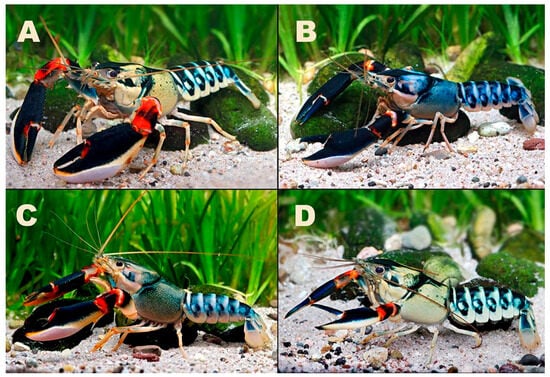
Figure 29.
Cherax nigli n. sp. (A) Holotype male (MZB Cru), Kaimana Regency, West Papua, Indonesia, (B) blue form, (C) green form; (D) allotype (MZB Cru), same data as holotype.
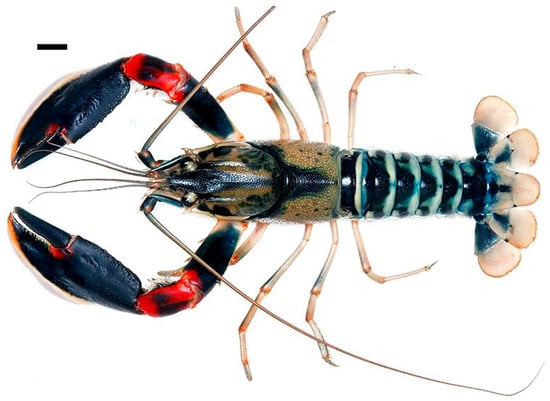
Figure 30.
Cherax nigli n. sp., holotype male (MZB Cru). Scale bar: 10 mm.
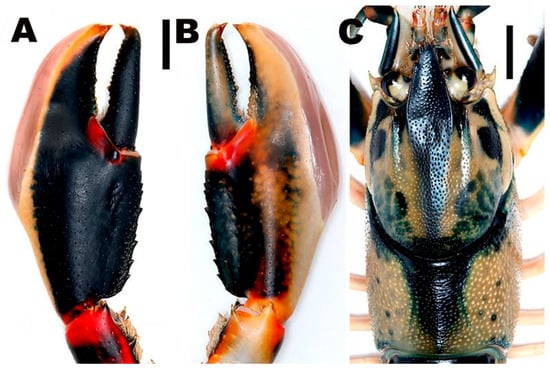
Figure 31.
Left chela and cephalothorax of Cherax nigli n. sp., holotype male (MZB Cru). (A) Left chela, dorsal view; (B) idem, ventral view; (C) cephalothorax, dorsal view. Scale bar: 10 mm.
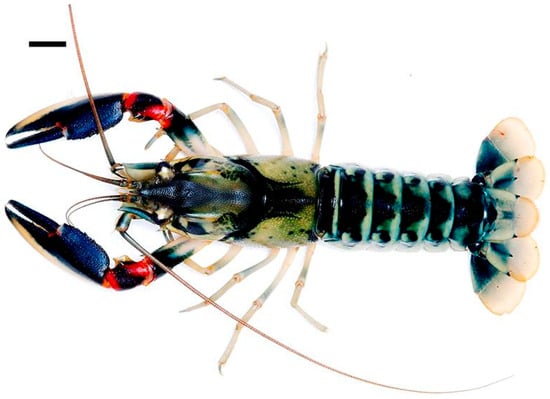
Figure 32.
Cherax nigli n. sp., allotype female (MZB Cru). Scale bar: 10 mm.
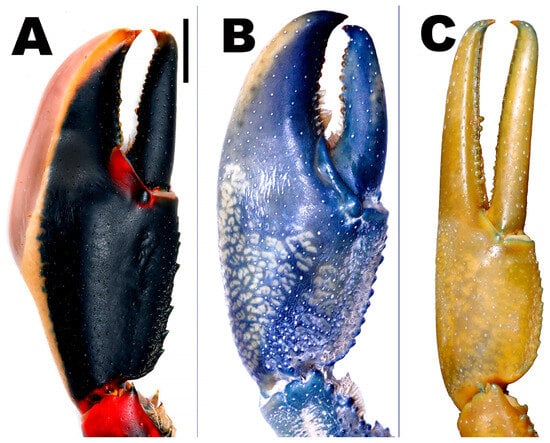
Figure 33.
Chelae comparison of Cherax nigli n. sp. (A) with C. communis (B) and C. paniaicus (C).
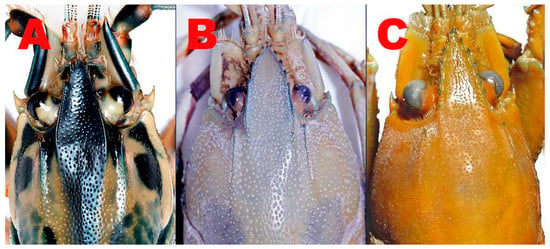
Figure 34.
Rostrum comparison of Cherax nigli n. sp. (A) with C. communis (B) and C. paniaicus (C).
Material examined. Holotype: male (MZB Cru), under rocks, wood, and among roots and in debris along banks of an unnamed river in the southeast of the Kaimana Regency, West Papua, Indonesia. Coll. local people, December 2024. Crayfish were sent to us by KKCrayfish Farm in Jakarta. Allotype: female (MZB Cru), same data as holotype. Paratypes: one male (MZB Cru); two males and one female (ZMB 34714); same data as holotype.
Diagnosis. Carapace surface smooth with numerous small tubercles posterior to cervical groove on lateral carapace. Eyes large, pigmented. Cornea slightly broader than eyestalk. Rostrum lanceolate in shape with excavated margins. Rostral margins with two prominent teeth. Rostral carinae prominent. Postorbital ridges prominent with one acute tubercle at anterior terminus. Prominent uncalcified patch on lateral margin of chelae of adult male white, translucent. Propodal cutting edge with row of small granules and two slightly larger tubercle. Chelipeds blue and white with white joints and a red spot right posterior to the joints. Fingers with hooked tips. Other walking legs creamy white with some reddish and blueish spots. Pleon dark blue with light blue and creamy transverse bands. Lateral pleura becoming creamy.
Description of male holotype (Figure 29, Figure 30 and Figure 31). Body and eyes pigmented (Figure 29). Eyes not reduced, darkly pigmented. Cornea slightly broader than eyestalk, as long as its eyestalk. Body subovate, slightly compressed laterally. Pleon narrower than cephalothorax (width 26.3 mm and 29.3 mm, respectively). Rostrum (Figure 31C) broad in shape, reaching middle of first antennular peduncle and about 1.5 times as long as wide (width 8.9 mm at base, length 13.5 mm). Margins slightly elevated, continuing in rostral carinae on carapace, almost straight in basal part. Acumen with anteriorly orientated spine. Rostral margins with two spines on each side on anterior third of rostrum. Few scattered hairs present on anterior third of rostrum. Rostrum surface with numerous tiny granules. Rostral carinae extending as slight elevations posteriorly on carapace, terminating at half of postorbital ridges. Postorbital ridges well developed, terminating in spiniform tubercle anteriorly, fading at half of occipital carapace length, posteriorly. Surface between rostral carinae heavily pitted. Postorbital ridges about 1/4 of CL. Cervical and branchiocardiac grooves distinct, not setose; 4–5 small granules present at middle part behind cervical groove on lateral sides of carapace. Carapace (59.4 mm) surface smooth; numerous granules posterior to cervical groove on lateral carapace present. Anterior margin strongly produced; rounded upper margin directed inward. Areola smooth, pitted, small granules present in the posterior quarter of the areola; length, 18.4 mm; narrowest width, 9.4 mm. Length of areola 31.0% of total length of carapace (59.4 mm). Scaphocerite, broadest at posterior third, convex in distal part becoming narrower in basal part; thickened lateral margin terminating in corneous spine, slightly overreaching ultimate segment of antennular peduncle. Left scaphocerite 14.1 mm long and 6 mm wide. Proximal margins setose. Antennulae and antennae typical for genus. Antennae slightly longer than body. Antennal protopodite smooth, without spine, with row of hairs on inner margin; basicerite with one lateral and one ventral spine. Mouthparts typical for genus. Epistome with subcordiform cephalic lobe anteriorly bearing lanceolate cephalomedian projection constricted at base. Lateral margins of lobe not thickened; each lateral margin with a group of 3–4 very small tubercles separated by a smooth region. Central part smooth, not pitted, excavate. First pereopods (Figure 31A,B) equal in form, chela slightly gaping. Left cheliped 59.6 mm long, 12.6 mm high, and 26.5 mm wide. Right chelae 59.1 mm long and 11.8 mm high, 25.2 mm wide, strongly compressed. Fingers shorter than palm (left dactylus 25.1 mm long). Dactylus broad at base (4.4 mm), tapering slightly toward tip. Tip with sharp, corneous, hooked tooth pointing outwards at an angle of 45°. Cutting edge of dactyl with continuous row of small granular teeth posteriorly and one slightly larger granule. Ventral and dorsal surface of movable finger smooth with scattered punctuation. Ventral posterior third of cutting edge with scattered setae reaching from base to slightly larger granule. Fixed finger smooth, scattered punctuation, triangular, merging gradually into palm, ending in sharp, corneous, hooked tooth, parallel to x-axis of finger. Tips of fingers slightly cross when fingers clasp. Upper surface of palm practically smooth, slightly pitted, more densely pitted at margins. Fixed finger broader than dactyl at base (11.2 mm). Scattered, short setae present in posterior ventral part of fixed finger, reaching from palm to about one-third of cutting edge. Cutting edge of fixed finger with row of rather small granular teeth at posterior half.
Outer lateral margin of chelae smooth with white, translucent patch covering about two-thirds of lateral margin. Row of 7–8 small mesial propodal granules with 4 more prominent spiny granules at dorsolateral margin. Dorsolateral margins slightly elevated in posterior half. Dorsal surface of carpus (14.4 mm) smooth, with slight excavation in middle part and with two well-developed mesial carpal spines. Ventral carpal surface margins slightly elevated, setose, and with fovea; inner margin with well-developed ventral carpal spine and prominent ventromesial carpal spine oriented at an angle of approximately 45°. Merus (35.2 mm) laterally depressed in basal part; surface smooth; prominent dorsal meral spine present. Inner ventrolateral margin smooth; four ventral meral spines present: one at first third, one at mid-length, other at tip of anterior part, and fourth on distal ventrolateral inner margin. Ischium (17.4 mm) smooth with two small spines at ventrolateral inner margin.
Second pereopods reaching anteriorly to approximately mid-length of scaphocerite. Propodus (15.5 mm) and dactylus (7.5 mm) slightly longer than fixed finger (6.8 mm), of same height. Few scattered, short setae present on dactyl and fixed finger. Cutting edge of dactyl and propodus with row of dense, short setae. Carpus (12.3 mm), smooth, slightly pitted. Merus 20.9 mm. Ischium (7.0 mm) about one-third as long as merus.
Third pereopods overreaching second pereopods to mid-length of carpus. Fingers shorter than palm. Fourth pereopods reaching distal margin of scaphocerite. Dactylus (4.5 mm) with corneous tip; no setae present. Propodus (16.0 mm) more than three times as long as dactylus, somewhat flattened, carrying many stiff setae on lower margin. Carpus (9.8 mm) about twice as long as dactylus. Merus (14.3 mm). Fifth pereopods similar to fourth, slightly shorter. Dorsal surface of pleon smooth, with scattered pits; abdominal segments (1–5) with short setae present on caudal margins of segment. Pleon length 68.6 mm. Telson with posterolateral spines; dense short setae present in posterior third. Posterior margins setose. Uropodal protopod with two distal spines on mesial lobe. Exopod of uropod with transverse row of posteriorly directed diminutive spines ending in one more prominent spine, posteriorly directed on outer margin of mesial lobe. Terminal half of exopod with small spines and short hairs, slightly corrugated. Endopod of uropod smooth. Short, scattered hairs present on posterior third of dorsal exopod. Posterolateral spine on outer margin present. Second spine on medial dorsal surface present, directed posteriorly. Total length 128.9 mm.
Description of female allotype (Figure 32). Chela of first pereopods equal, 2.5 times as long as broad (31.8 mm and 12.4 mm, respectively). Mesial margin of palm slightly elevated, forming slender serrated ridge with row of 10–11 small granular teeth, of which 6 are a bit bigger and spinier. Cutting edge of dactylus with 10–11 rather small granular teeth, 1 slightly bigger. Cutting edge of fixed finger with 10–11 small granules, 1 slightly bigger. Small scattered, short setae visible along ventral cutting edges of chelae, denser and longer in ventral posterior area. Tips of fingers slightly cross when fingers clasp, not gaping. No soft patch present. Pleon narrower than cephalothorax (width 22.4 mm and 24.1 mm, respectively). Rostrum broad in shape, reaching middle of first antennular peduncle and about 1.5 times as long as wide (width 7.7 mm at base, length 11.8 mm). Margins slightly elevated continuing in rostral carinae on carapace, almost straight in basal part, distal third, pointing upwards at an angle of approximately 45°. Acumen with anteriorly orientated spine. Rostral margins with two spines on each side on anterior third. Few scattered hairs present on anterior third of rostrum. Rostral carinae extending as slight elevations posteriorly on carapace, terminating at half of postorbital ridges. Postorbital ridges well developed, terminating in spiniform tubercle anteriorly, fading at half of occipital carapace length, posteriorly. Postorbital ridges about 1/4 of CL. Cervical and branchiocardiac grooves distinct, not setose; 4–5 small granules present at middle part behind cervical groove on lateral sides of carapace. Carapace surface smooth; numerous granules posterior to cervical groove on lateral carapace present. Anterior margin strongly produced; rounded upper margin directed inward. Areola smooth, pitted, small granules present in posterior quarter of areola; length, 15.6 mm; narrowest width 9.4 mm. Length of areola 31.4% of total length of carapace (49.7 mm). Same color pattern as in males. Total length 111.0 mm.
Size. The variation in size in the studied sample of C. nigli n. sp. is given in Table 2, which also provides comparisons with all other newly described species.
Color. The living animals (Figure 29A–D) are colored as follows. Individuals of C.nigli n. sp. usually have blue and white chelipeds with white joints and a red spot right posterior to the joints (Figure 29A). Fingers dark blue with orange yellowish hooked tips. Carpus often red and black. In the blue color variation (Figure 29B), the carpus is often also dark blue. Body is creamy or yellowish with dark green pattern on the dorsal carapax, becoming creamy ventrally. Some individuals have light blue coloration with dark blue pattern or more greenish with a dark green pattern on the dorsal carapace (Figure 29C). Walking legs creamy white with some reddish and blueish spots. Some individuals have blueish walking legs. Pleon dark blue with light blue and creamy transverse bands. Lateral pleura becoming creamy. Females (Figure 29D): same color as males with smaller chelae. Females do not show the creamy white soft patch.
Molecular phylogenetic results. Cherax nigli n. sp. forms a highly supported, distinct clade that is a sister species to a highly supported clade comprising C. communis and C. paniaicus. The clade comprising these three species is moderately (16S; Figure 5) or highly supported (16S and COI combined; Figure S1), respectively, and its relationship to the other species in the northern group is unresolved. Cherax nigli n. sp. is well isolated from C. communis and C. paniaicus, with a sequence divergence (p-distance) of 4.1–4.5% (16S) and 3.8–4.2% (16S)/11.0–11.2% (COI), respectively, supporting the morphology-based description of C. nigli as a new species.
Systematic remarks. In comparison to all species of the northern group, the new species Cherax nigli n. sp. is morphologically and genetically most similar to C. paniaicus and C. communis. Cherax nigli n. sp. may be easily distinguished from both species by the coloration and pattern of live individuals, by the shape of the chelae (Figure 33), by the shape of the rostrum (Figure 34), and by DNA barcoding (Figure 5 and Figure S1).
Color comparison. Individuals of Cherax nigli n. sp. usually have blue and white chelipeds with white joints and a red spot right posterior to the joints. Fingers dark blue with orange yellowish hooked tips. Carpus often red and black. In the blue color variation, the carpus is often also dark blue. Body is creamy or yellowish with dark green pattern on the dorsal carapace becoming creamy ventrally. C. communis has azure-blue chelae, sometimes greenish-blue. Body usually greenish-blue with some brown. The chelae in C. paniaicus are usually blueish-grey, the body is dark grey to almost black dorsally.
Chelae comparison (Figure 33A–C). In Cherax nigli n. sp. (Figure 33A), the movable finger is usually 1/6 shorter than the dorsolateral margin of the palm. Soft patch is present in the males covering about two-thirds of the lateral margin. Row of 7–8 small mesial propodal granules with 4 more prominent spiny granules at dorsolateral margin. In C. communis (Figure 33B), the movable finger is about as long as the dorsolateral margin of the palm. No soft patch at the outer margin of the palm is present in males. The dorsolateral margins of the palm are just slightly elevated, with a row of 10–11 rather weakly developed granules present. Scattered, short setae are present on the ventral part of the fixed finger and palm. In C. paniaicus (Figure 33C), the movable finger is about one-third longer than the dorsolateral margin of the palm. No setae are present on the ventral part of the fixed finger and palm. No soft patch at the outer margin of the palm is present in males.
Rostrum comparison (Figure 34A–C). The rostral margins of Cherax nigli n. sp. (Figure 34A) have two spines on each side on anterior third of rostrum, while the rostrum of C. communis (Figure 34B) has 5–6 spiny granules and the rostrum of C. paniaicus (Figure 34C) 6–8 spiny granules on each side of the rostrum. In Cherax nigli n. sp., the rostrum is 1.4 times as long as broad, in C. communis 1.3 times, and in C. paniaicus 1.5 times as long as broad.
Systematic position. Molecular work in particular has shown that the traditional classification of Cherax into two subgenera is not justified, supporting rather a division into three lineages, dubbed the southwestern group, eastern group, and northern group [30,33] (see a short overview by Lukhaup et al. 2024 [14] for more details). Our molecular phylogenetic results (Figure 5), as well as the morphological data [20,23,32,33], clearly showed that Cherax nigli n. sp. belongs to the northern species group lineage, now consisting of 35 species.
Ecology. Cherax nigli n. sp. is endemic to creeks and rivers in the southern part of Kaimana Regency. To protect the species, we will not reveal the exact location. One of the creeks harboring these crayfish is clear, shallow (20–120 cm), with a moderate flow. The temperature is around 23–25 °C. In most parts, no water plants are present. The substrate of the creek is soil, mostly covered with silt and detritus. Crayfish hide in short burrows in the riverbank, under larger rocks or wood, or in detritus that is present in all the parts of the creek. The creek is surrounded by forest. To improve the knowledge of the distribution of this species, more field surveys will be necessary.
Distribution (Figure 9). Southeast of Kaimana Regency, West Papua, Indonesia.
Common name. As the common name for this crayfish, we propose the Peacock Crayfish, as it is already available under this name in the pet trade.
Etymology. Cherax nigli n. sp. is named in honor of Herbert Nigl, an aquarium wholesaler who for the last 25 years supported us by helping to obtain new crayfish species from Papua. His continuing effort is essential for achieving a better understanding of the crayfish of this region.
Cherax veritas n. sp.
Figure 35, Figure 36, Figure 37, Figure 38, Figure 39, Figure 40, Figure 41, Figure 42 and Figure 43.
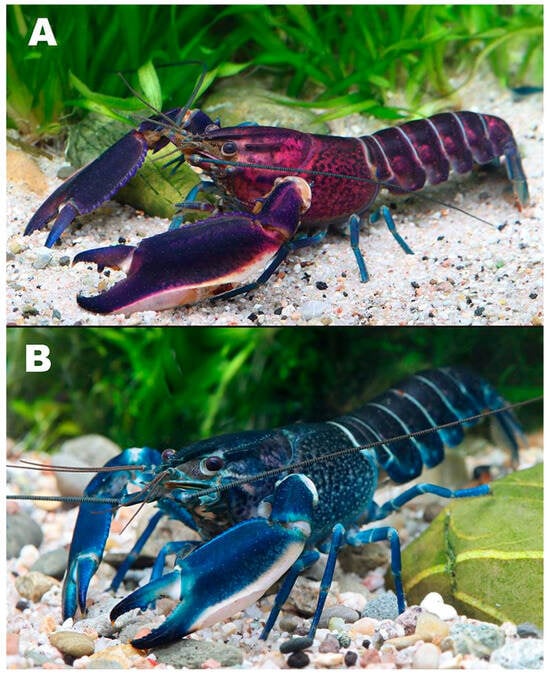
Figure 35.
Cherax veritas n. sp. (A) Holotype male (MZB Cru), unnamed Creek close to Tomolol, Raja Ampat Regency, West Papua, Indonesia. (B) Paratype (MZB Cru), same data as holotype.
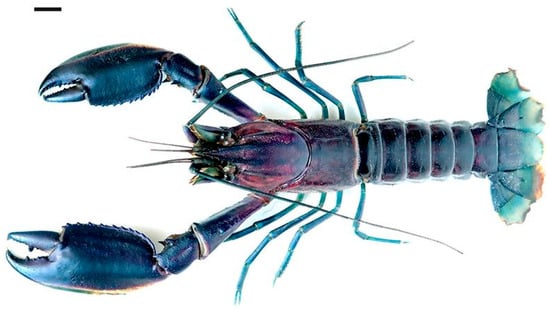
Figure 36.
Cherax veritas n. sp., holotype male (MZB Cru.) Scale bar: 10 mm.
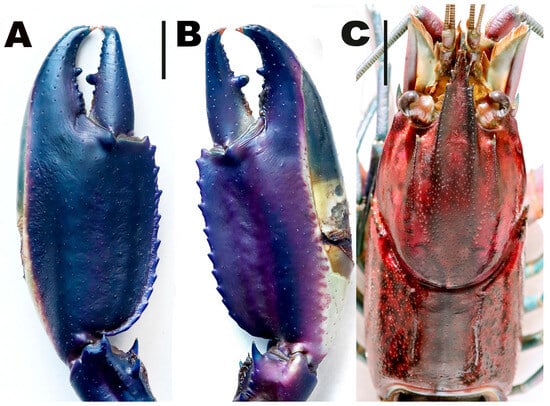
Figure 37.
Left chela and cephalothorax of Cherax veritas n. sp., holotype male (MZB Cru). (A) Left chela, dorsal view; (B) idem, ventral view; (C) cephalothorax, dorsal view. Scale bar: 10 mm.
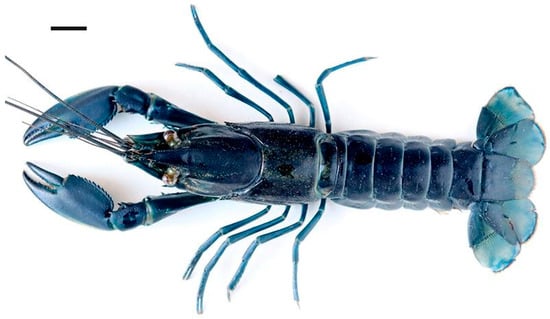
Figure 38.
Cherax veritas n. sp., allotype female (MZB Cru). Scale bar: 10 mm.
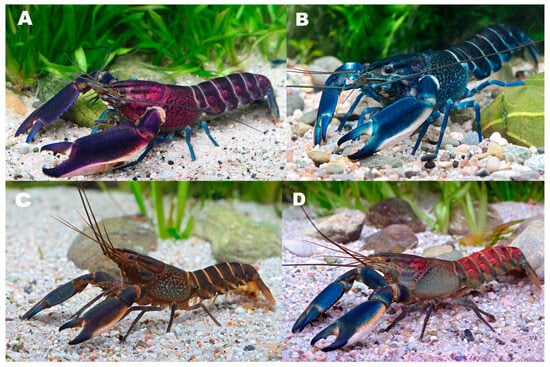
Figure 39.
Coloration comparison of Cherax veritas n. sp. with C. mosessalossa and C. warsamsonicus. (A) Cherax veritas n. sp. from Tomolol, Misool Island; (B) blue form; (C) C. mosessalossa from the type locality in Sorong, Sorong Regency, Kepala Burung; (D) C. warsamsonicus from the type locality, Warsamson River, Sorong Regency, Kepala Burung.
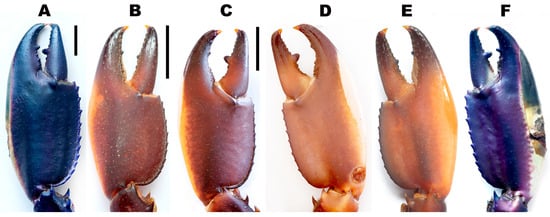
Figure 40.
Comparison of left chelae of C. veritas n. sp. (A,D) with C. mosessalossa (B,E) and C. warsamsonicus (C,F). (A–C) Dorsal view and (D–F) ventral view.
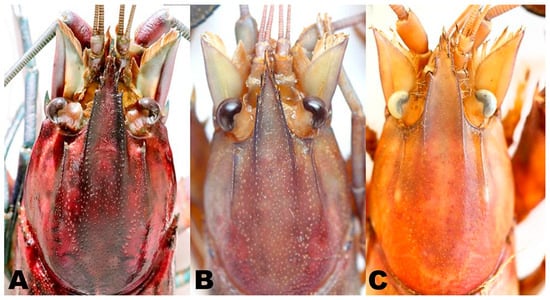
Figure 41.
Rostrum comparison of Cherax veritas n. sp. (A) with C. mosessalossa (B) and C. warsamsonicus (C).
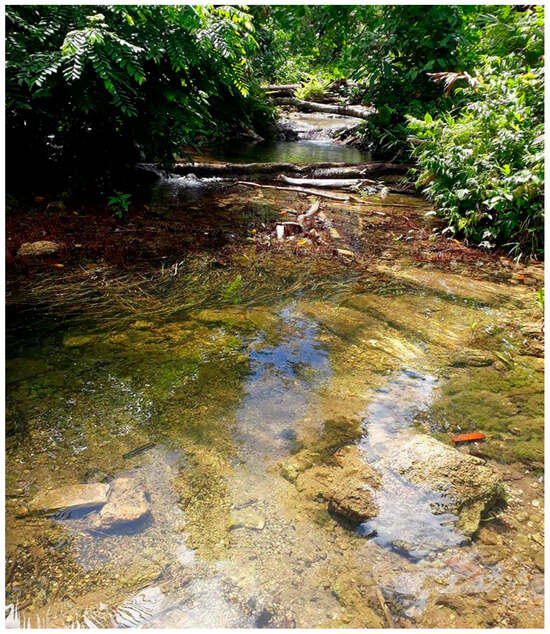
Figure 42.
Shallow creek close to the village of Tomolol, habitat of Cherax veritas n. sp.
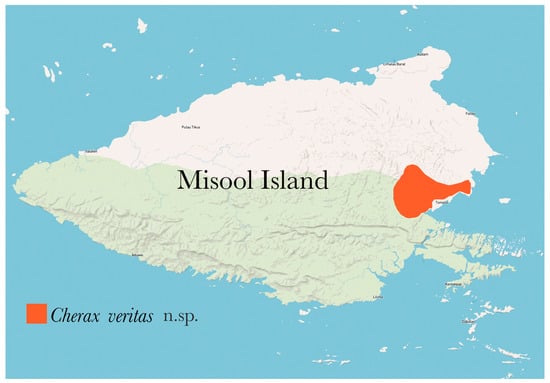
Figure 43.
Misool Island, Raja Ampat Regency, West Papua, Indonesia, with the distribution of C. veritas n. sp.
Material examined. Holotype: male (MZB Cru), under rocks, wood, and among roots and in debris along banks of an unnamed creek close to the village of Tomolol in the southeastern part of Misool Island, of Raja Ampat Regency, West Papua, Indonesia. Coll. local people, June 2022. Crayfish were sent to us by KKCrayfish Farm in Jakarta. Allotype: female (MZB Cru), same data as holotype. Paratypes: two males (MZB Cru); three males and one female (ZMB 34710); same data as holotype.
Diagnosis. Carapace surface smooth with numerous tiny tubercles posterior to cervical groove on lateral carapace. Eyes large, pigmented. Cornea slightly broader than eyestalk. Rostrum lanceolate in shape, excavated in middle part, margins elevated. Rostral margins with two prominent teeth. Rostral carinae prominent. Postorbital ridges prominent with one acute tubercle at anterior terminus. First legs equal in form, subequal in size, left cheliped largest, about as long as carapace. Prominent uncalcified patch on lateral margin of chelae, white, translucent. Propodal cutting edge with row of five small granules in posterior half and one larger tubercle at mid-length. Cutting edge of dactylus with 5–6 small granules and 1 large tubercle at mid-length. Chelipeds blueish-purple and white with white joints. Fingers with hooked tips. Other walking legs light blue to dark blue. Pleon dark purple with light blue and creamy transverse bands. Lateral pleura becoming slightly lighter. Pink spots on lateral pleura present.
Description of male holotype (Figure 35, Figure 36 and Figure 37). Body and eyes pigmented (Figure 35 and Figure 36). Eyes not reduced, rather large; cornea globular, darkly pigmented, nearly as long as eyestalk. Cornea slightly broader than eyestalk. Body subovate, slightly compressed laterally. Pleon narrower than cephalothorax (width 22.5 mm and 24.7 mm, respectively). Rostrum (Figure 37C) broad in shape, reaching end of first antennular peduncle and about 2.1 times as long as wide (width 7.1 mm at base, length 15.3 mm). Margins slightly elevated continuing in rostral carinae on carapace, almost straight in basal part. Acumen with anteriorly orientated spine. Few scattered hairs present on anterior third of rostral margins. Three well-developed spines on the right side of rostrum and three on the left side. Rostral carinae extending as slight elevations posteriorly on carapace, terminating at half of postorbital ridges. Postorbital ridges well developed, terminating in spiniform tubercle anteriorly, fading at half of occipital carapace length posteriorly. Postorbital ridges about 1/3 of CL. Cervical and branchiocardiac grooves distinct, not setose; four prominent spines present at middle part behind cervical groove on lateral sides of carapace. Carapace (56.2 mm) surface smooth; numerous tiny granules posterior to cervical groove on lateral carapace present. Anterior margin strongly produced; rounded upper margin directed inward. Areola smooth, scarcely pitted; length, 16.2 mm; narrowest width, 9.6 mm. Length of areola 28.9% of total length of carapace (56.2 mm). Scaphocerite, broadest at posterior third, convex in distal part becoming narrower in basal part; thickened lateral margin terminating in corneous spine, slightly overreaching ultimate segment of antennular peduncle. Right scaphocerite 13.9 mm long and 5.2 mm wide. Proximal margins setose. Antennulae and antennae typical for genus. Antennae slightly longer than body. Antennal protopodite smooth, without spine, with row of hairs on inner margin; basicerite with one lateral and one ventral spine. Mouthparts typical for genus. Epistome with subcordiform cephalic lobe anteriorly bearing lanceolate cephalomedian projection constricted at base. Lateral margins of lobe not thickened; each lateral margin with group of 8–10 very small tubercles separated by smooth region; central part smooth, not pitted, excavate. First pereopods (Figure 37A,B) equal in form, subequal in size, left cheliped largest, about as long as carapace; chelae gaping. Left cheliped 58.6 mm long, 11.1 mm high, and 24 mm wide, strongly compressed. Right chelae 49.1 mm long and 9. 3 mm high, 20.4 mm wide, strongly compressed. Right chelae regrown. Fingers shorter than palm (right dactylus 19.9 mm long). Dactylus broad at base (8.0 mm), tapering slightly toward tip. Tip with sharp, corneous, hooked tooth pointing outwards at an angle of 45°. Cutting edge of dactylus with 5–6 small granules and 1 large tubercle at mid-length. Ventral and dorsal surface of movable finger smooth with scattered punctuation. Ventral posterior third of cutting edge with short setae reaching from base to larger granule. Fixed finger smooth, scattered punctuation, triangular, merging gradually into palm, ending in sharp, corneous, hooked tooth, parallel to x-axis of finger. Tips of fingers slightly cross when fingers clasp. Upper surface of palm practically smooth, slightly pitted. Fixed finger broader than dactyl at base (11.7 mm). Scattered, short setae present in posterior ventral part of fixed finger, reaching from palm to about one-third of cutting edge. Propodal cutting edge with row of five small granules in the posterior half and one larger tubercle at mid-length.
Outer lateral margin of chelae smooth with white, translucent patch covering about two-thirds of lateral margin; row of 9–10 small mesial propodal granules at dorsolateral margin. Dorsolateral margins slightly elevated after first fifth. Dorsal surface of carpus (16.5 mm) smooth, with slight excavation in middle part and with two well-developed mesial carpal spines. Ventral carpal surface margins slightly elevated, not setose, and with fovea; inner margin with well-developed ventral carpal spine and prominent ventromesial carpal spine oriented at an angle of approximately 45°. Merus (27.6 mm) laterally depressed in basal part; surface smooth; prominent dorsal meral spine present; inner ventrolateral margin smooth; four ventral meral spines present; one at first third, one at mid-length, other at tip of anterior part, and fourth on distal ventrolateral inner margin. Ischium (14.2 mm) smooth with one small spine and one bigger at ventrolateral inner margin.
Second pereopods reaching anteriorly to approximately tip of scaphocerite. Propodus (12.7 mm) and dactylus (6.8 mm) slightly longer than fixed finger (6.0 mm), of same height. Few scattered, short setae present on dactyl and fixed finger. Cutting edge of dactyl and propodus with row of tiny, short setae. Carpus (10.2 mm), smooth, slightly pitted. Merus (17.7 mm), smooth, slightly pitted. Ischium (6.9 mm) smooth, slightly pitted.
Third pereopods overreaching second pereopods to mid-length of carpus. Fingers shorter than palm. Fourth pereopods reaching distal margin of scaphocerite. Dactylus (4.3 mm) with corneous tip; no setae present. Propodus (12.8 mm) about three times as long as dactylus, somewhat flattened, carrying many stiff setae on lower margin. Carpus (9.1 mm) about twice as long as dactylus. Merus 14.7 mm. Fifth pereopods similar to fourth, slightly shorter. Dorsal surface of pleon smooth, with scattered pits; abdominal segments (1–5) with short setae present on caudal margins of segment. Pleon length 67.5 mm. Telson with posterolateral spines; dense short setae present in posterior third; posterior margins setose. Uropodal protopod with two distal spines on mesial lobe. Exopod of uropod with transverse row of posteriorly directed diminutive spines ending in one more prominent spine, posteriorly directed on outer margin of mesial lobe. Terminal half of exopod with small spines and short hairs, slightly corrugated. Endopod of uropod smooth. Short, scattered hairs present on posterior third of dorsal exopod. Posterolateral spine on outer margin present. Second spine on medial dorsal surface present, directed posteriorly.
Description of female allotype (Figure 38). Chela of first pereopods equal, 2.5 times as long as broad (33.0 mm and 13.3 mm, respectively). Mesial margin of palm slightly elevated, forming slender serrated ridge with rows of 10–11 small granular teeth. Cutting edge of dactylus with 8–9 rather small granular teeth, 1 slightly larger. Ventral posterior third of cutting edge with short setae reaching from base to about larger granule. Cutting edge of fixed finger with 6–7 small granules, 1 slightly bigger. Short dense setae present in posterior part of cutting edge. Tips of fingers slightly cross when fingers clasp, not gaping. No soft patch present. Pleon narrower than cephalothorax (width 22.0 mm and 23.1 mm, respectively). Rostrum broad in shape, reaching middle of first antennular peduncle and about 2.3 times as long as wide (width 5.9 mm at base, length 13.6 mm). Margins slightly elevated, continuing in rostral carinae on carapace, almost straight in basal part, distal third, pointing upwards at an angle of approximately 45°. Acumen with anteriorly orientated spine. Few scattered hairs present on anterior third of rostrum. Rostrum with three spines in anterior part on the left side of rostrum and two on the right side. Rostral carinae extending as slight elevations posteriorly on carapace terminating at half of postorbital ridges. Postorbital ridges well developed, terminating in spiniform tubercle anteriorly, fading at half of occipital carapace length, posteriorly. Postorbital ridges about 1/3 of CL. Cervical and branchiocardiac grooves distinct, not setose; three spines present at middle part behind cervical groove on lateral sides of carapace. Carapace surface smooth; numerous tiny granules posterior to cervical groove on lateral carapace present. Anterior margin strongly produced; rounded upper margin directed inward. Areola smooth, pitted, length, 15.9 mm; narrowest width, 9.7 mm. Length of areola 31.5% of total length of carapace (50.5 mm). Same color pattern as in males. Total length 112.7 mm.
Size. The variation in size in the studied sample of C. veritas n. sp. is given in Table 2, which also provides comparisons with all other newly described species.
Color. The living animals (Figure 35A,B) are colored as follows. Individuals of Cherax veritas n. sp. usually have blue and white chelipeds with white joints or dark purple–pinkish and white chelipeds with white joints (Figure 35A). Fingers dark blue or dark purple getting lighter at middle length, with orange-yellowish hooked tips. Body is dark purple or dark blue with black spots. The blue variety (Figure 35B) has white spots as well on the lateral carapace. Walking legs dark to light blue. Pleon in the blue variety is dark blue with thin light blue transverse bands. Lateral pleura becoming slightly lighter blue. In the purple variety (not shown), the pleon is dark purple with some pinkish spots on the lateral pleura. Lateral pleura also becoming lighter purple. Females: same color as males. Females do not show the creamy white soft patch.
Molecular phylogenetic results. Cherax veritas n. sp. forms a highly supported, distinct clade that is the sister species to C. mosessalossa with moderate support; both species are, in turn, sister to C. warsamsonicus (Figure 5). The clade comprising these three species is highly supported and very distinct; it forms a highly supported clade with C. boesemani, C. gherardii, C. phing, C. pulcher, C. pulverulentus, C. wagenknechtae, and C. woworae. The relationship of these species to the clade containing Cherax veritas n. sp. is unresolved. Cherax veritas n. sp. is well isolated from C. mosessalossa and C. warsamsonicus, with a sequence divergence (p-distance, 16S) of 1.9–2.0% and 2.2–2.6%, respectively, supporting the morphology-based description of C. veritas as a new species.
Systematic position. C. veritas n. sp. belongs to the northern species group lineage, now consisting of 35 species (please see the respective section for C. nigli n. sp. below for details).
Systematic remarks. In comparison to all species of the northern group, C. veritas n. sp. is morphologically and genetically most similar to C. mosessalossa and C. warsamsonicus. Cherax veritas n. sp. can be easily distinguished from both species by the coloration and pattern of live individuals (Figure 39), by the shape of the chelae (Figure 40), by the shape of the rostrum (Figure 41), and by using DNA barcoding (Figure 5).
Chelae comparison (Figure 40A–F). In C. veritas n. sp., the chelae are 2.9 times longer than the movable finger, while in C. warsamsonicus the chelae are 2.5 times longer than the movable finger and in C. mosessalossa, 2.3 times longer. In C. veritas n. sp., the dorsolateral margins are well developed, while weaker developed in C. mosessalossa and C. warsamsonicus. In C. veritas n. sp., the chelae are, on average, 2.4 times as long as broad, while 2.1 times as long as broad in C. mosessalossa and 2.3 times as long as broad in C. warsamsonicus.
Rostrum comparison (Figure 41A–C). The rostrum of Cherax veritas n. sp. is well developed, rather straight and triangular shaped, on average 2.4 times as long as broad. The rostrum of C. mosessalossa is, on average, 2.1 times as long as broad, while the rostrum of C. warsamsonicus is clearly bent outwards at the middle part and 2.3 times as long as broad. C. veritas n. sp. has four prominent spines present at middle part behind cervical groove on lateral sides of carapace, while C. mosessalossa has three prominent corneous spines and two smaller spines present, and C. warsamsonicus has one prominent corneous spine and three tubercles present. C. veritas n. sp. is found close to Tomolol Village in the southeastern part of Misool Island of Raja Ampat Regency, while C. mosessalossa and C. warsamsonicus are found in the Sorong Regency, Kepala Burung.
Ecology. One of the creeks harboring these crayfish is clear, shallow (20–80 cm), with a moderate flow (Figure 42). The temperature is around 23–25 °C. In most parts, no water plants are present. The substrate of the creek is soil mostly covered with silt and detritus. Crayfish hide in short burrows in the riverbank, under larger rocks or wood, or in detritus that is present in all the parts of the creek. The creek is surrounded by forest. To improve the knowledge of the distribution of this species, more field surveys will be necessary.
Distribution (Figure 43). Cherax veritas n. sp. has so far only been found in creeks close to the village of Tomolol in the southeastern part of Misool Island of Raja Ampat Regency. It is likely that it occurs at least throughout the entire catchment.
Common name. As the common name for this crayfish, we propose Veritas Amethyst Crayfish, as it is already available under this name in the pet trade.
Etymology. Cherax veritas n. sp. is named after the roman goddess of truth, “Veritas”. With this name, we want to honor Julian Paul Assange, an Australian editor and activist who founded Wikileaks. His aim was to make illegal and unethical activities of governments and institutions accessible to the public. He inspired the first author for a determined fight for a better and fair future for all of us. It is proposed as a noun in apposition.
Supplementary Materials
The following supporting information can be downloaded at: https://www.mdpi.com/article/10.3390/arthropoda3020010/s1. Figure S1: Phylogenetic relationships of four of the new species of Cherax within the northern New Guinea Cherax lineage, reconstructed by BI analyses of the combined 16S rRNA and cytochrome oxidase subunit I mitochondrial gene fragments.
Author Contributions
Conceptualization, C.L.; methodology, C.L. and T.v.R.; data analysis, C.L., R.E. and T.v.R., writing—original draft preparation, C.L.; writing—review and editing, C.L., R.E. and T.v.R.; visualization, C.L. and T.v.R. All authors have read and agreed to the published version of the manuscript.
Funding
This research received no external funding.
Data Availability Statement
The new sequences have been made available in GenBank, other data are available upon request from the first author.
Acknowledgments
Liauw Pauw Phing is thanked for bringing these species to our attention, for his immense help in obtaining them, and for providing information about their location. We would like to thank Aquarium Dietzenbach for importing these species. Robert Schreiber (MfN) kindly performed the genetic lab work. Daisy Wowor is thanked for her cooperation.
Conflicts of Interest
The authors declare no conflict of interest.
References
- Holthuis, L.B. Decapoda Macrura with a Revision of the New Guinea Parastacidae. Zoological Results of the Dutch New Guinea Expedition 1939. No. 3. Nova Guin. N.S. 1949, 5, 289–328. [Google Scholar]
- Holthuis, L.B. Native Fisheries of Freshwater Crustacea in Netherlands New Guinea. Contributions to New Guinea Carcinology. Nova Guin. N.S. 1956, 7, 123–137. [Google Scholar]
- Holthuis, L.B. Freshwater Crayfish in Netherlands New Guinea Mountains. South Pac. Comm. Q. Bull. 1958, 8, 36–39. [Google Scholar]
- Holthuis, L.B. Freshwater Crustacea Decapoda of New Guinea. In Biogeography and Ecology of New Guinea; Monographiae Biologicae; Springer: Dordrecht, The Netherlands, 1982; Volume 42, pp. 603–619. [Google Scholar]
- Holthuis, L.B. The Freshwater Crayfish of New Guinea. Freshw. Crayfish 1986, 6, 48–58. [Google Scholar]
- Holthuis, L.B. Cherax (Astaconephrops) minor New Species, a Parastacid from the Mountains of Irian Jaya (W. New Guinea), Indonesia (Crustacea: Decapoda: Parastacidae). Zool. Meded. 1996, 70, 361–366. [Google Scholar]
- Lukhaup, C.; Pekny, R. Cherax (Cherax) holthuisi, a New Species of Crayfish (Crustacea: Decapoda: Parastacidae) from the Centre of the Vogelkop Peninsula in Irian Jaya (West New Guinea), Indonesia. Zool. Meded. 2007, 80, 101–107. [Google Scholar]
- Lukhaup, C.; Pekny, R. Cherax (Astaconephrops) boesemani, a New Species of Crayfish (Crustacea: Decapoda: Parastacidae) from the Centre of the Vogelkop Peninsula in Irian Jaya (West New Guinea), Indonesia. Zool. Meded. 2008, 82, 331–340. [Google Scholar]
- Lukhaup, C.; Herbert, B. A New Species of Freshwater Crayfish (Crustacea: Decapoda: Parastacidae) from the Fly River Drainage, Western Province, Papua New Guinea. Mem. Qld. Mus. 2008, 52, 213–219. [Google Scholar]
- Lukhaup, C. Cherax (Astaconephrops) pulcher, a New Species of Freshwater Crayfish (Crustacea, Decapoda, Parastacidae) from the Kepala Burung (Vogelkop) Peninsula, Irian Jaya (West Papua), Indonesia. ZooKeys 2015, 502, 1–10. [Google Scholar] [CrossRef]
- Lukhaup, C.; Panteleit, J.; Schrimpf, A. Cherax snowden, a New Species of Crayfish (Crustacea, Decapoda, Parastacidae) from the Kepala Burung (Vogelkop) Peninsula in Irian Jaya (West Papua), Indonesia. ZooKeys 2015, 518, 1–14. [Google Scholar] [CrossRef]
- Lukhaup, C.; Eprilurahman, R.; von Rintelen, T. Cherax warsamsonicus, a New Species of Crayfish from the Kepala Burung (Vogelkop) Peninsula in West Papua, Indonesia (Crustacea, Decapoda, Parastacidae). ZooKeys 2017, 660, 151–167. [Google Scholar] [CrossRef]
- Lukhaup, C.; Eprilurahman, R.; von Rintelen, T. Two New Species of Crayfish of the Genus Cherax from Indonesian New Guinea (Crustacea, Decapoda, Parastacidae). ZooKeys 2018, 769, 89–116. [Google Scholar] [CrossRef]
- Lukhaup, C.; Eprilurahman, R.; Von Rintelen, T. Two New Species of Crayfish of the Genus Cherax (Crustacea, Decapoda, Parastacidae) from Western and Eastern Indonesian New Guinea. Arthropoda 2024, 2, 264–293. [Google Scholar] [CrossRef]
- Patoka, J.; Bláha, M.; Kouba, A. Cherax (Astaconephrops) gherardii, a New Crayfish (Decapoda: Parastacidae) from West Papua, Indonesia. Zootaxa 2015, 3964, 526–536. [Google Scholar] [CrossRef]
- Patoka, J.; Bláha, M.; Kouba, A. Cherax acherontis (Decapoda: Parastacidae), the First Cave Crayfish from the Southern Hemisphere (Papua Province, Indonesia). Zootaxa 2017, 4363, 137–144. [Google Scholar] [CrossRef]
- Patoka, J.; Akmal, S.G.; Bláha, M.; Kouba, A. Cherax woworae, a New Freshwater Crayfish (Decapoda: Parastacidae) from Southwest Papua Province, Indonesia. Zootaxa 2023, 5325, 582–592. [Google Scholar] [CrossRef]
- Patoka, J.; Akmal, S.G.; Bláha, M.; Kouba, A. Cherax pulverulentus, a New Freshwater Crayfish (Decapoda: Parastacidae) from Southwest Papua Province, Indonesia. Zootaxa 2025, 5566, 522–534. [Google Scholar] [CrossRef]
- Lukhaup, C.; Eprilurahman, R. A New Species of Crayfish of the Genus Cherax from Indonesian New Guinea (Crustacea, Decapoda, Parastacidae). Zoosystematics Evol. 2022, 98, 411–425. [Google Scholar] [CrossRef]
- Crandall, K.A.; Fitzpatrick, J.F. Crayfish Molecular Systematics: Using a Combination of Procedures to Estimate Phylogeny. Syst. Biol. 1996, 45, 1–26. [Google Scholar] [CrossRef]
- Folmer, O.; Black, M.; Hoeh, W.; Lutz, R.; Vrijenhoek, R. DNA Primers for Amplification of Mitochondrial Cytochrome c Oxidase Subunit I from Diverse Metazoan Invertebrates. Mol. Mar. Biol. Biotechnol. 1994, 3, 294–299. [Google Scholar]
- Katoh, K.; Standley, D.M. MAFFT Multiple Sequence Alignment Software Version 7: Improvements in Performance and Usability. Mol. Biol. Evol. 2013, 30, 772–780. [Google Scholar] [CrossRef]
- Posada, D. jModelTest: Phylogenetic Model Averaging. Mol. Biol. Evol. 2008, 25, 1253–1256. [Google Scholar] [CrossRef]
- Swofford, D.L. PAUP* (Version 4.0). Phylogenetic Analysis Using Parsimony (*and Other Methods); Sinauer Associates: Sunderland, MA, USA, 2002. [Google Scholar]
- Nguyen, L.T.; Schmidt, H.A.; Von Haeseler, A.; Minh, B.Q. IQ-TREE: A Fast and Effective Stochastic Algorithm for Estimating Maximum-Likelihood Phylogenies. Mol. Biol. Evol. 2015, 32, 268–274. [Google Scholar] [CrossRef]
- Trifinopoulos, J.; Nguyen, L.T.; von Haeseler, A.; Minh, B.Q. W-IQ-TREE: A Fast Online Phylogenetic Tool for Maximum Likelihood Analysis. Nucleic Acids Res. 2016, 44, W232–W235. [Google Scholar] [CrossRef]
- Hoang, D.T.; Chernomor, O.; Von Haeseler, A.; Minh, B.Q.; Vinh, L.S. UFBoot2: Improving the Ultrafast Bootstrap Approximation. Mol. Biol. Evol. 2018, 35, 518–522. [Google Scholar] [CrossRef]
- Ronquist, F.; Teslenko, M.; van der Mark, P.; Ayres, D.L.; Darling, A.; Höhna, S.; Larget, B.; Liu, L.; Suchard, M.A.; Huelsenbeck, J.P. MrBayes 3.2: Efficient Bayesian Phylogenetic Inference and Model Choice across a Large Model Space. Syst. Biol. 2012, 61, 539–542. [Google Scholar] [CrossRef]
- Tamura, K.; Stecher, G.; Kumar, S. MEGA11: Molecular Evolutionary Genetics Analysis Version 11. Mol. Biol. Evol. 2021, 38, 3022–3027. [Google Scholar] [CrossRef]
- Bláha, M.; Patoka, J.; Kozák, P.; Kouba, A. Unrecognized Diversity in New Guinean Crayfish Species (Decapoda, Parastacidae): The Evidence from Molecular Data. Integr. Zool. 2016, 11, 457–468. [Google Scholar] [CrossRef]
- Gan, H.M.; Tan, M.H.; Eprilurahman, R.; Austin, C.M. The Complete Mitogenome of Cherax monticola (Crustacea: Decapoda: Parastacidae), a Large Highland Crayfish from New Guinea. Mitochondrial DNA 2016, 27, 337–338. [Google Scholar] [CrossRef]
- Munasinghe, D.H.N.; Murphy, N.P.; Austin, C.M. Utility of Mitochondrial DNA Sequences from Four Gene Regions for Systematic Studies of Australian Freshwater Crayfish of the Genus Cherax (Decapoda: Parastacidae). J. Crustac. Biol. 2003, 23, 402–417. [Google Scholar] [CrossRef]
- Munasinghe, D.H.N.; Burridge, C.P.; Austin, C.M. The Systematics of Freshwater Crayfish of the Genus Cherax Erichson (Decapoda: Parastacidae) in Eastern Australia Re-Examined Using Nucleotide Sequences from 12S rRNA and 16S rRNA Genes. Invertebr. Syst. 2004, 18, 215. [Google Scholar] [CrossRef]
Disclaimer/Publisher’s Note: The statements, opinions and data contained in all publications are solely those of the individual author(s) and contributor(s) and not of MDPI and/or the editor(s). MDPI and/or the editor(s) disclaim responsibility for any injury to people or property resulting from any ideas, methods, instructions or products referred to in the content. |
© 2025 by the authors. Licensee MDPI, Basel, Switzerland. This article is an open access article distributed under the terms and conditions of the Creative Commons Attribution (CC BY) license (https://creativecommons.org/licenses/by/4.0/).